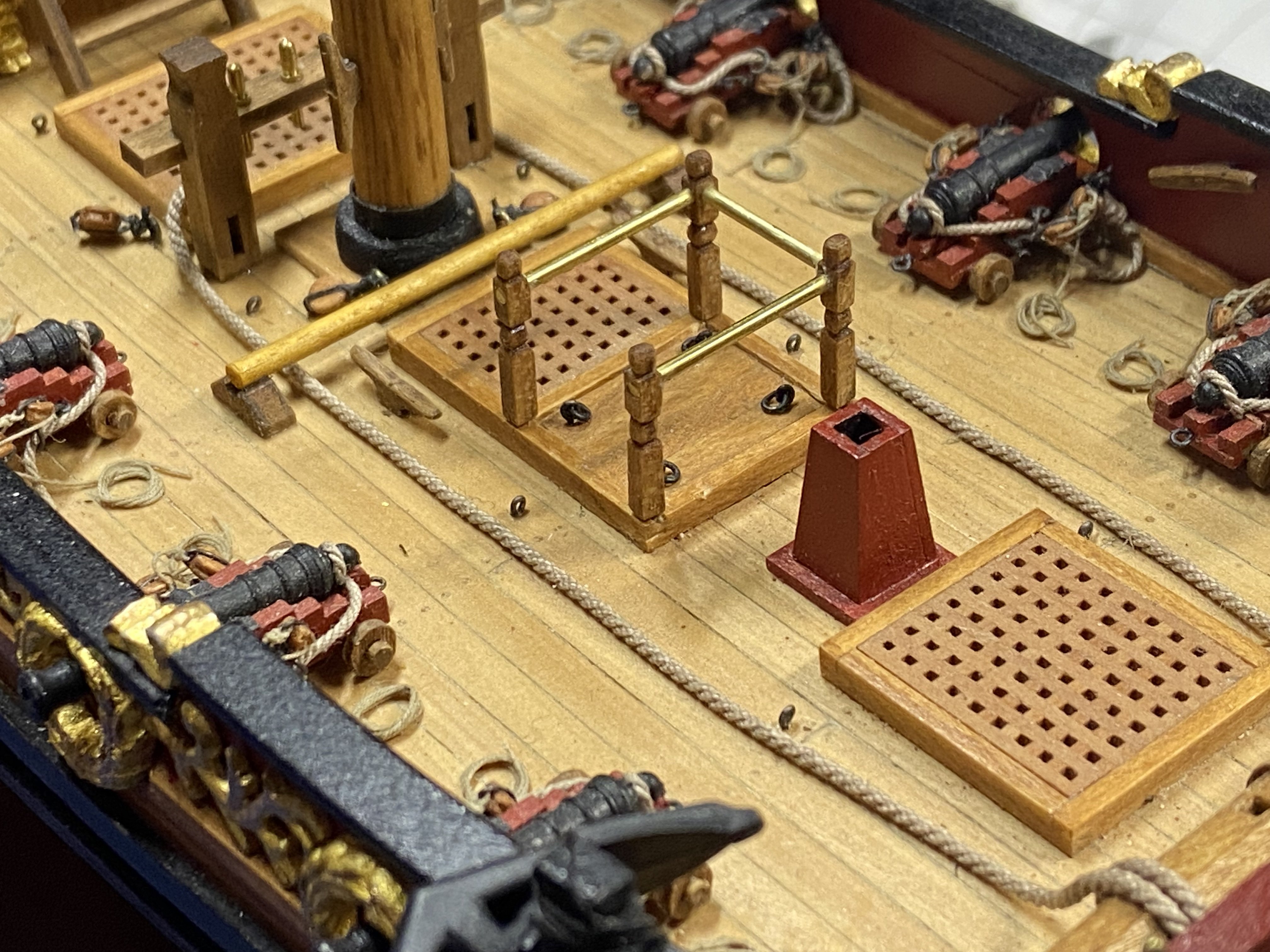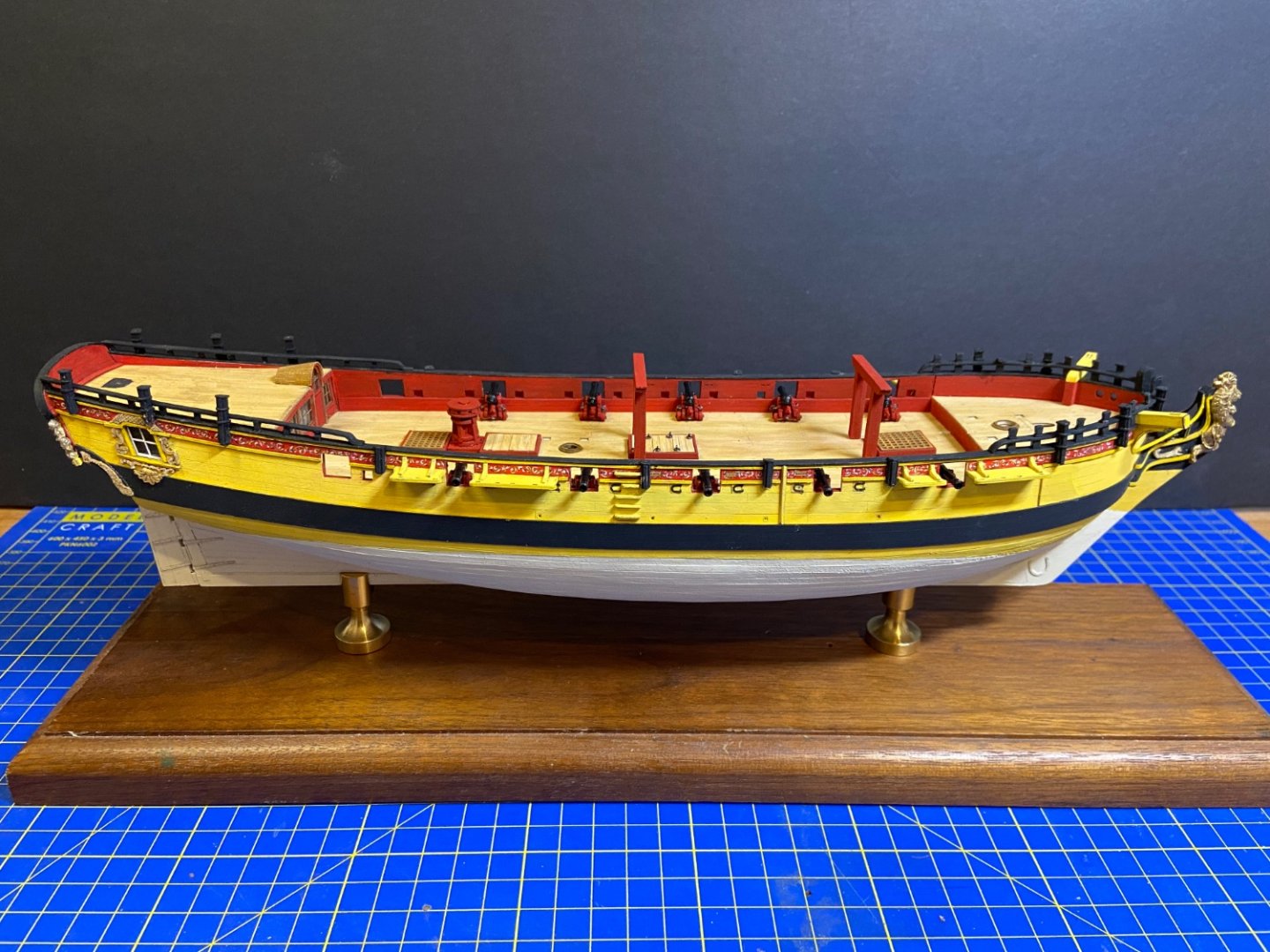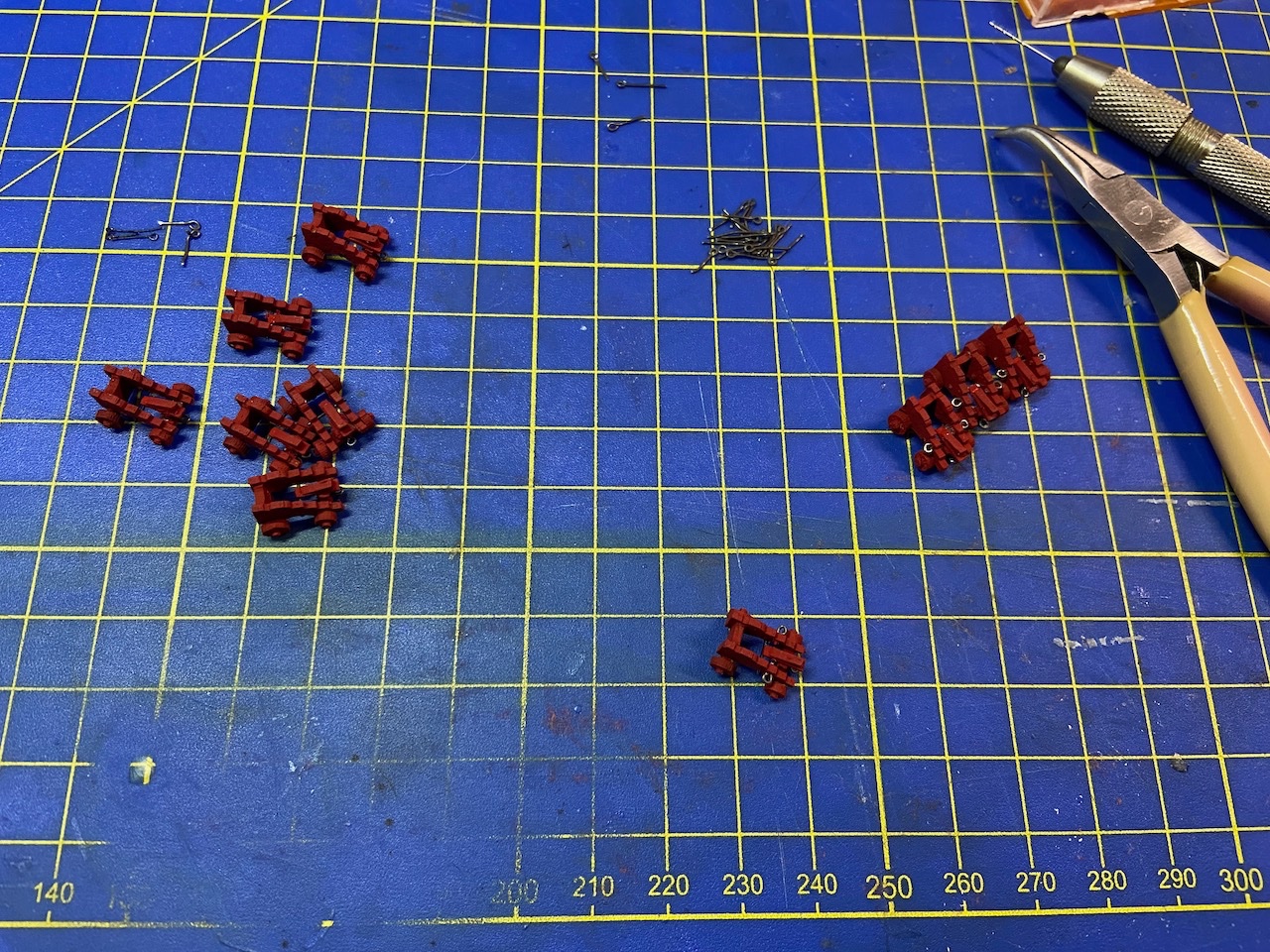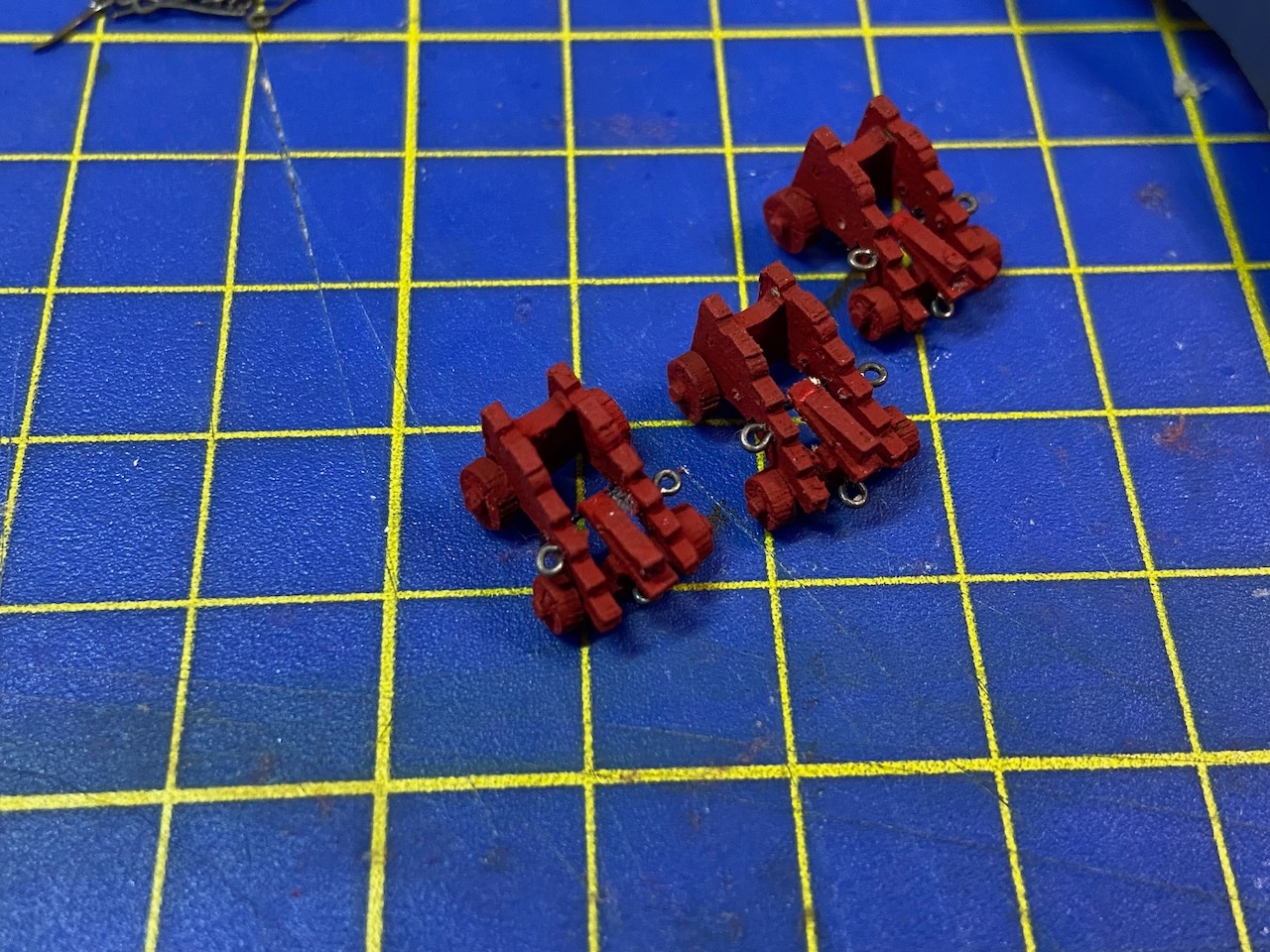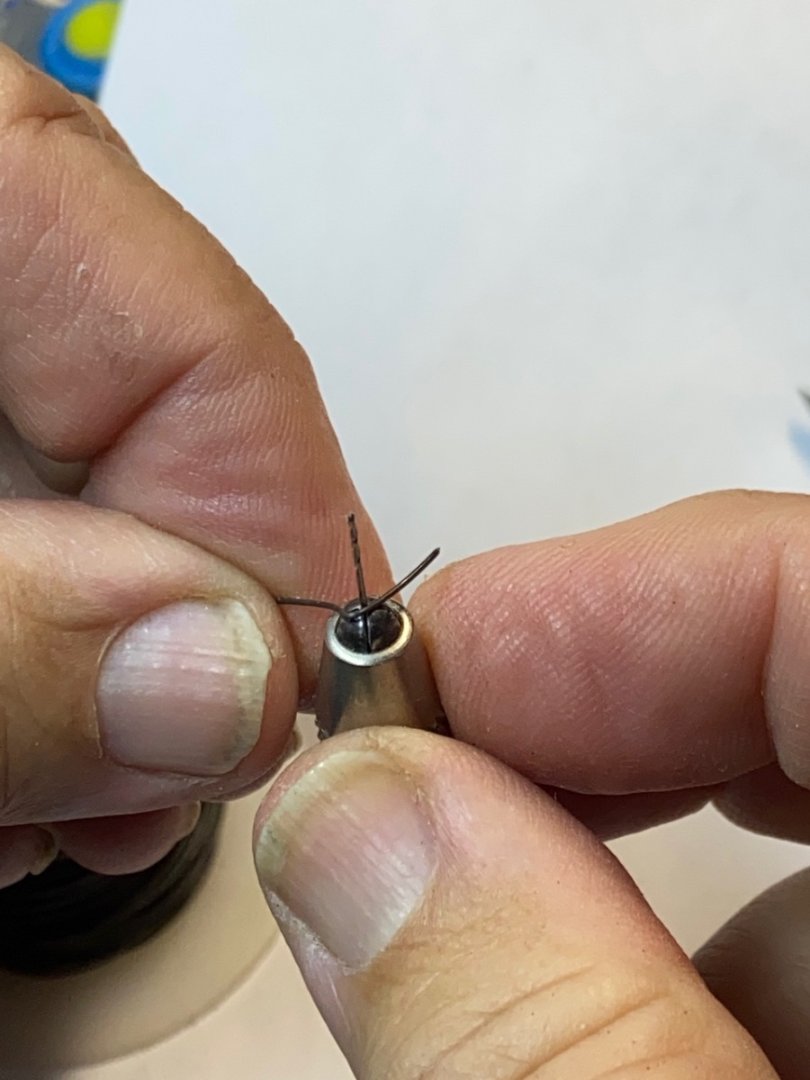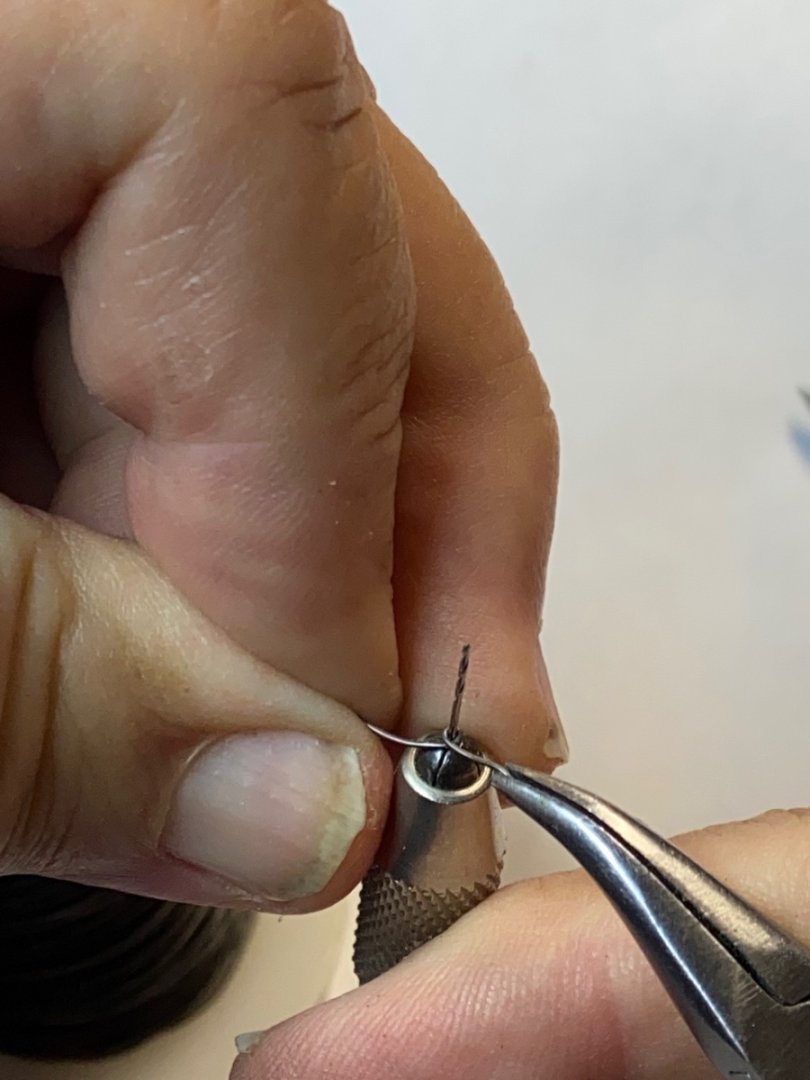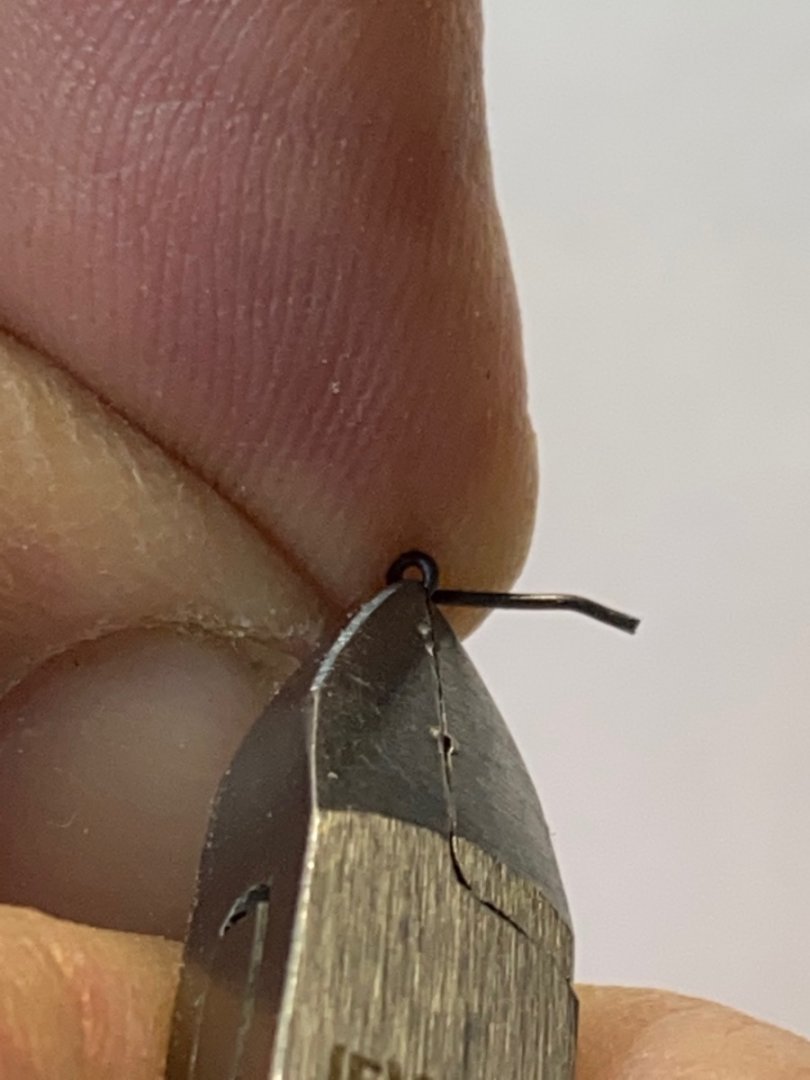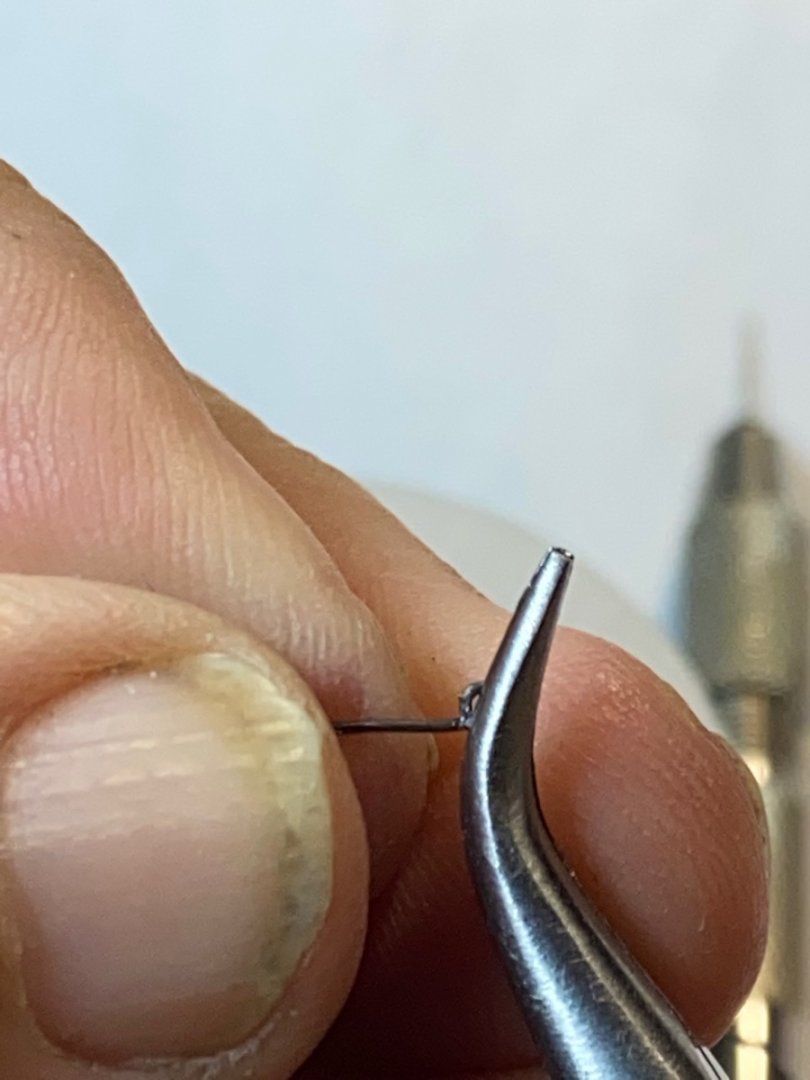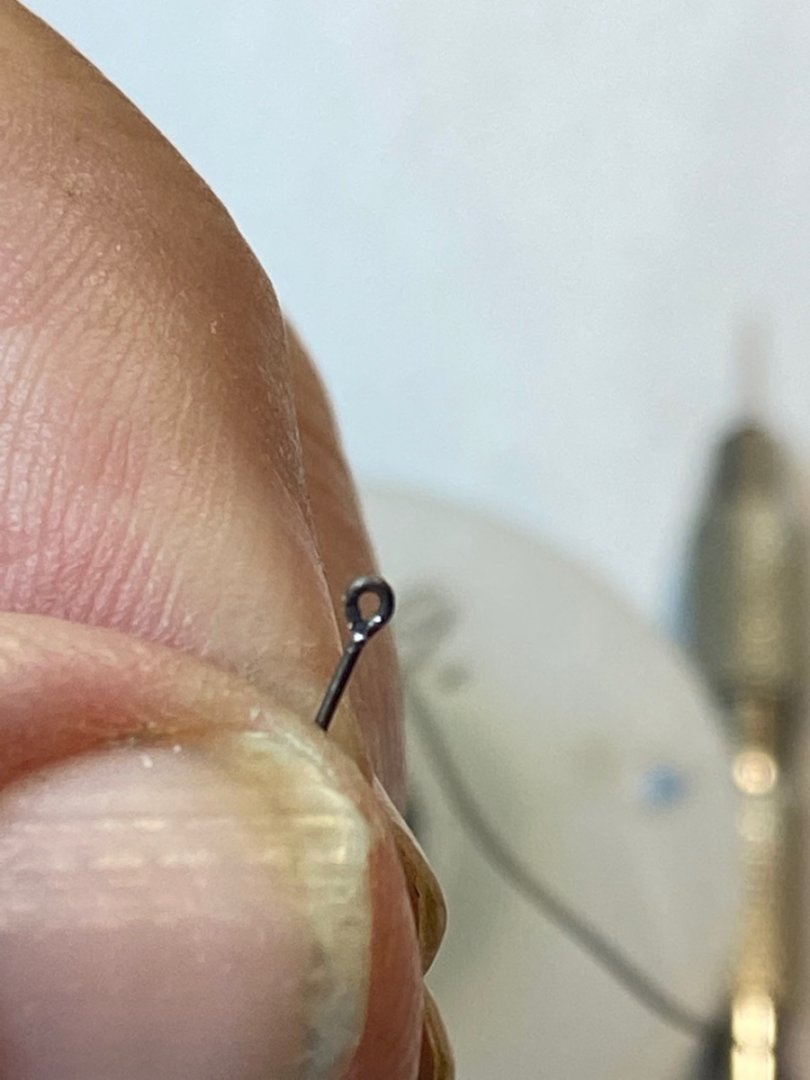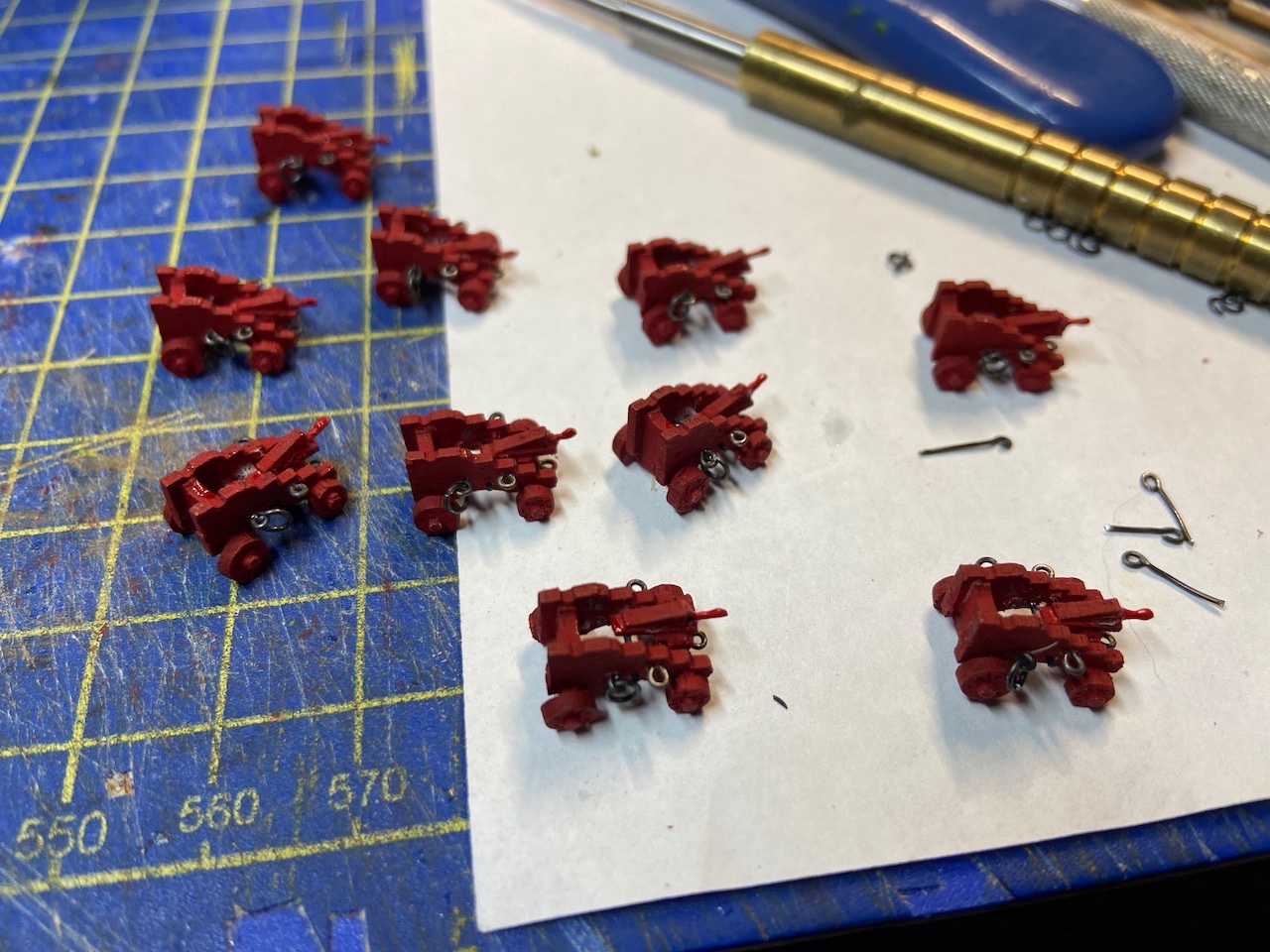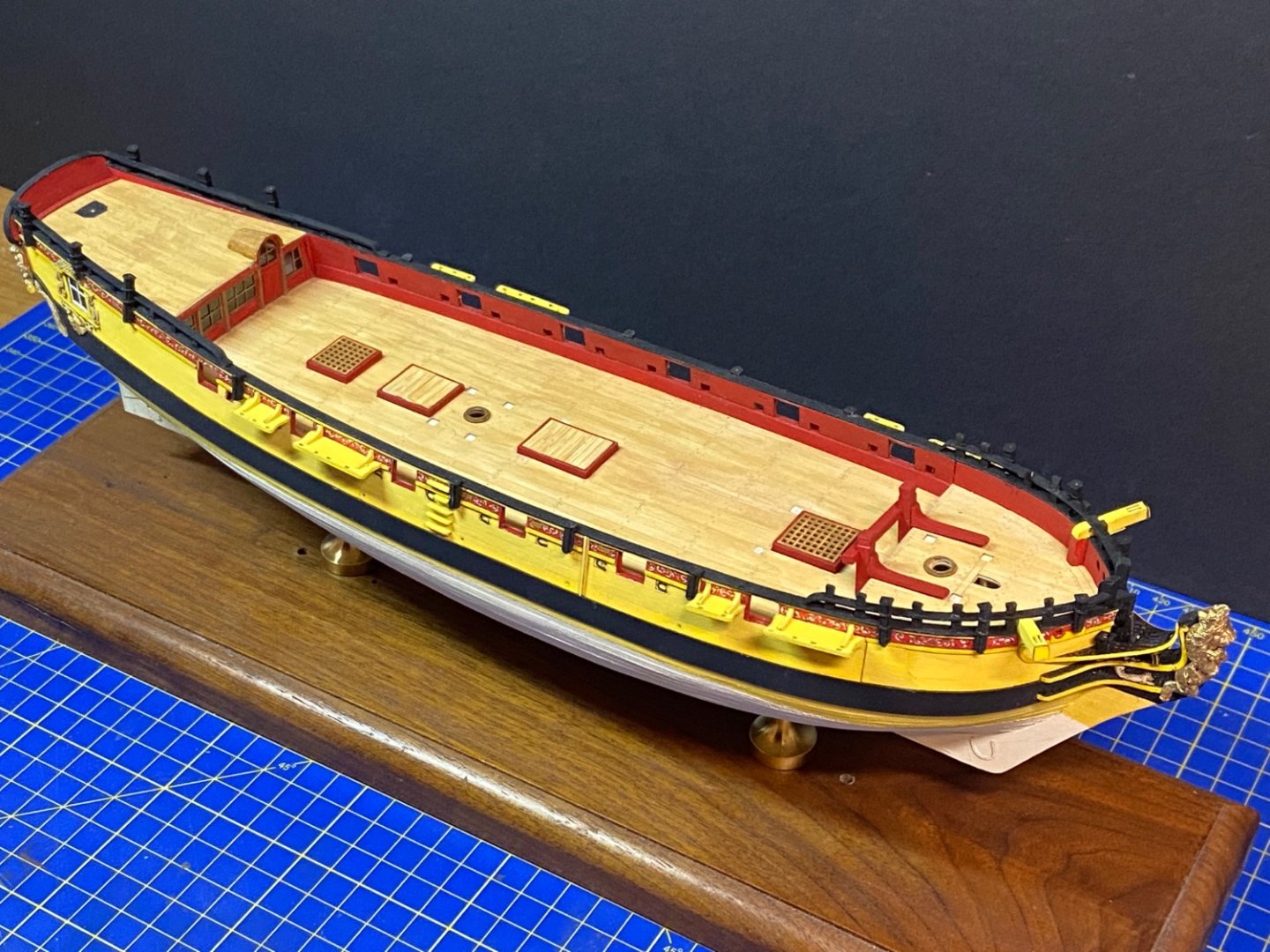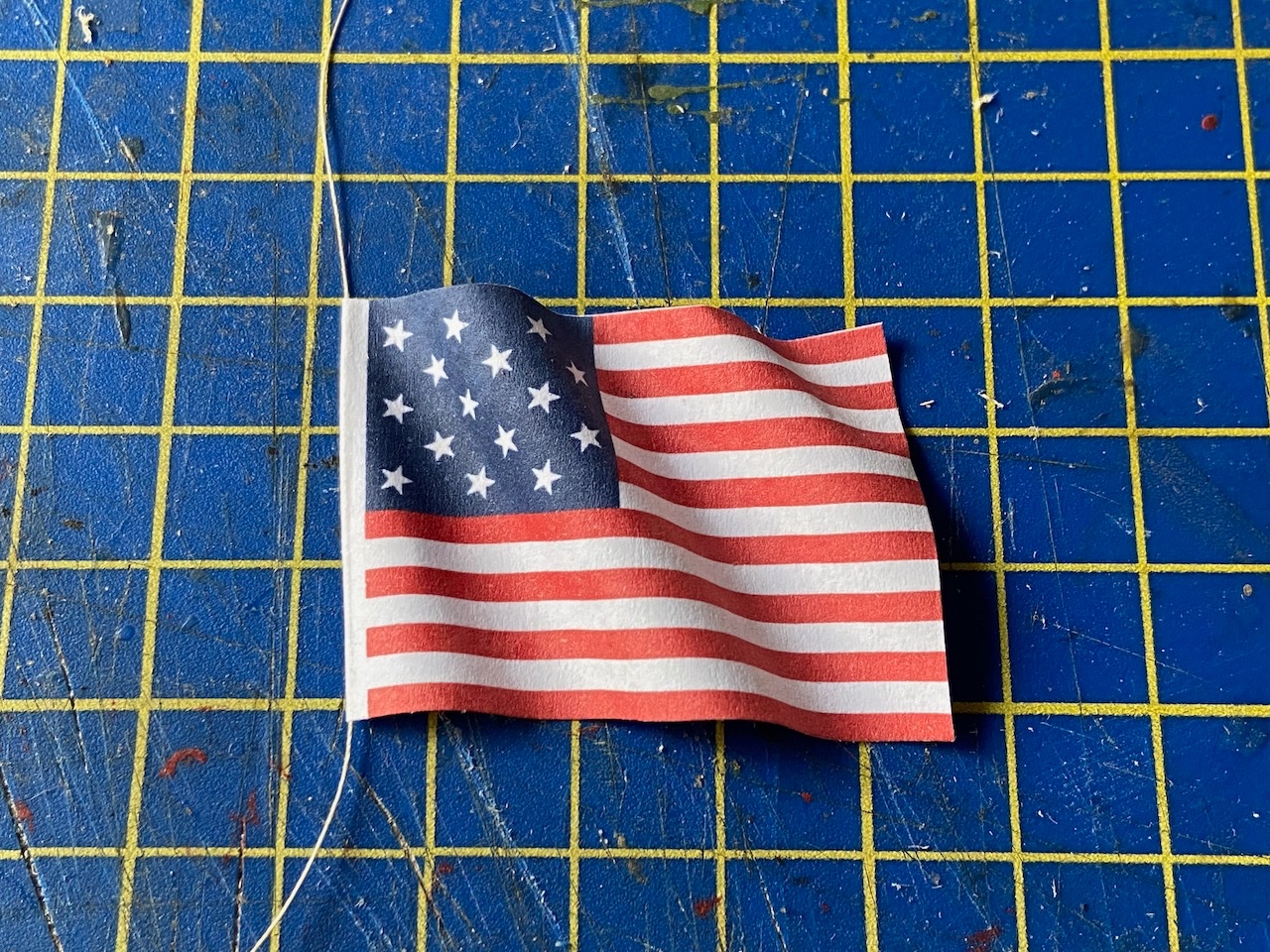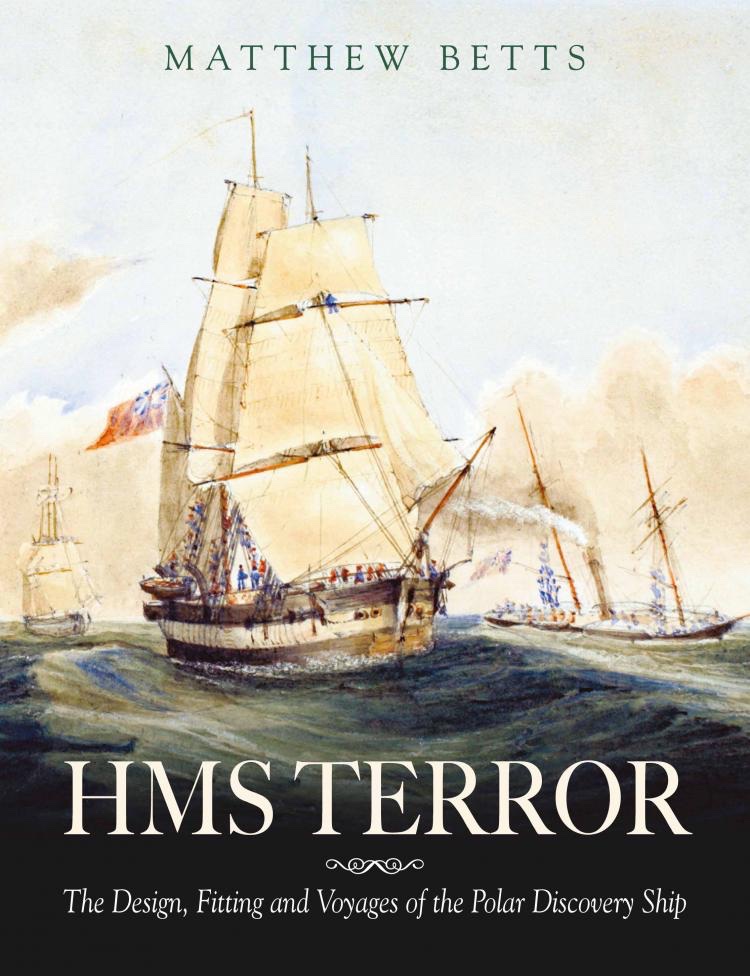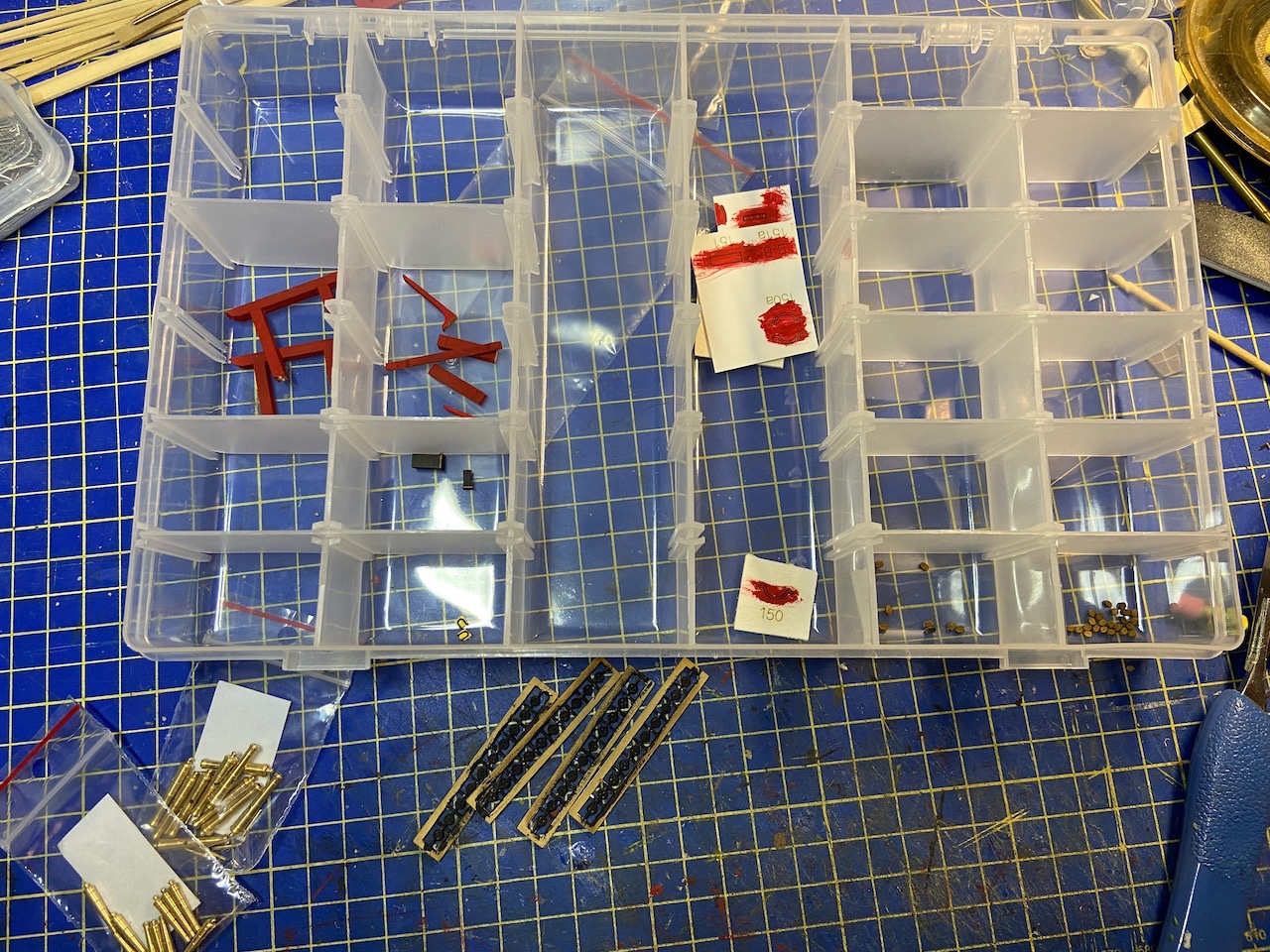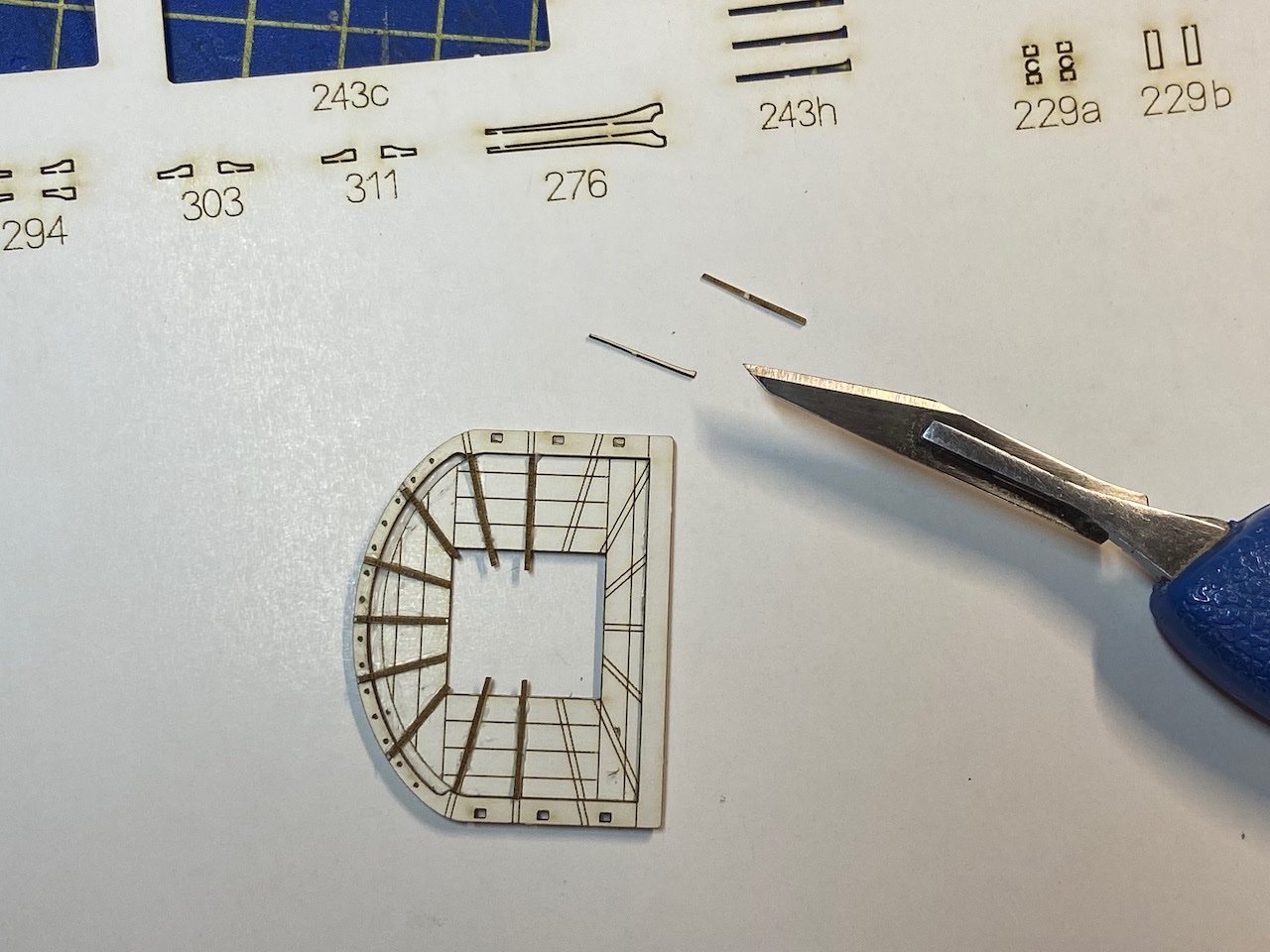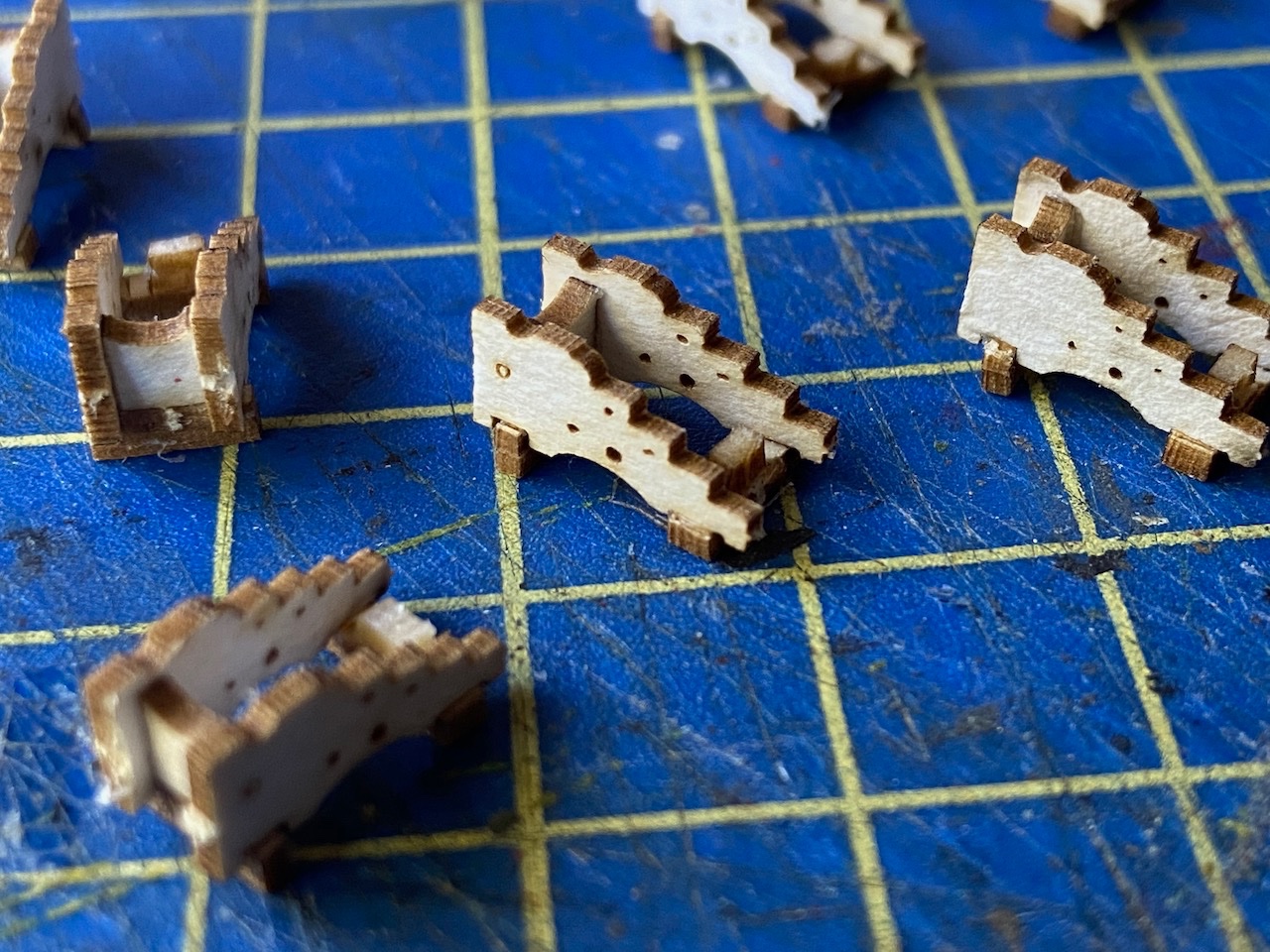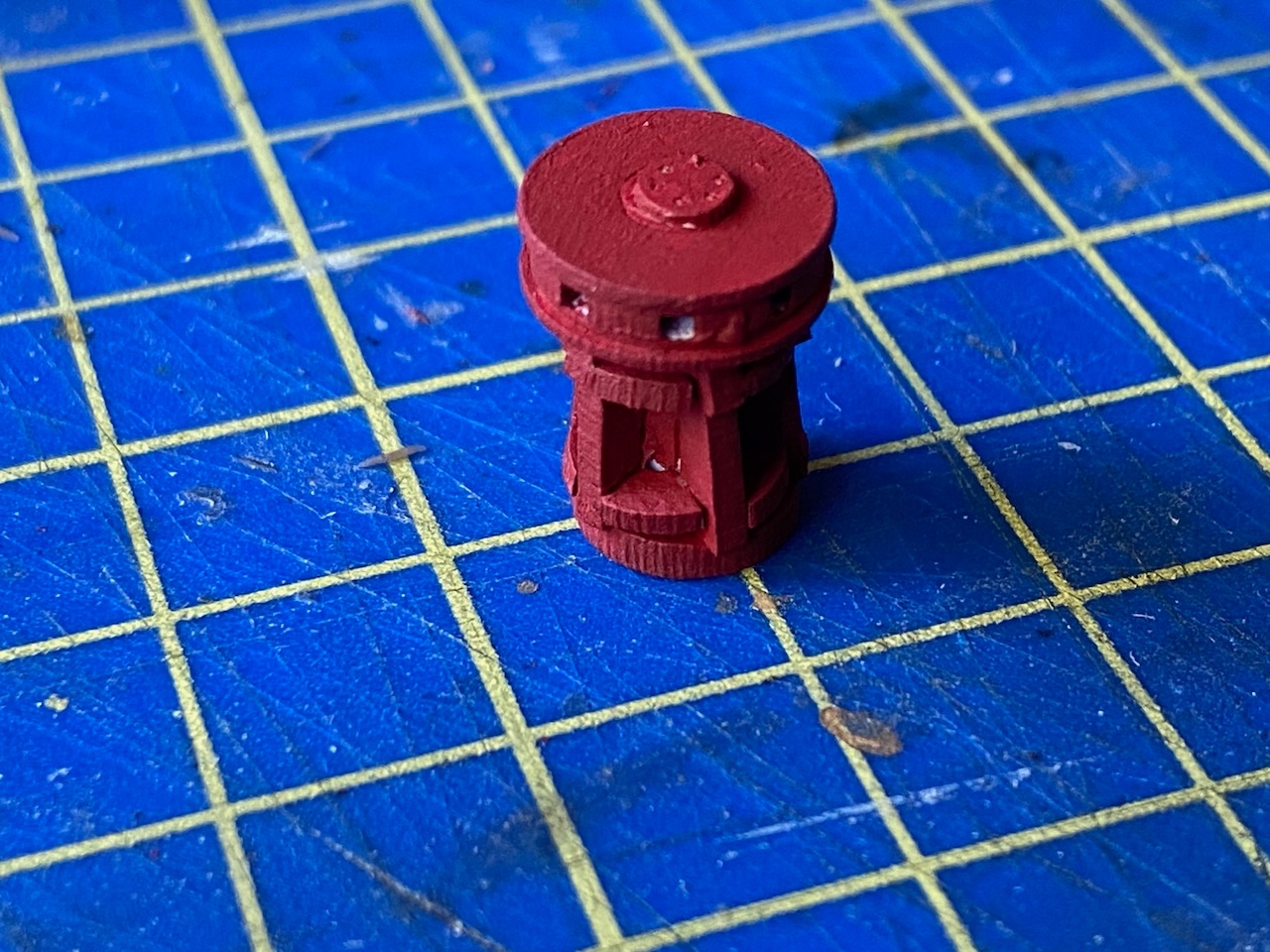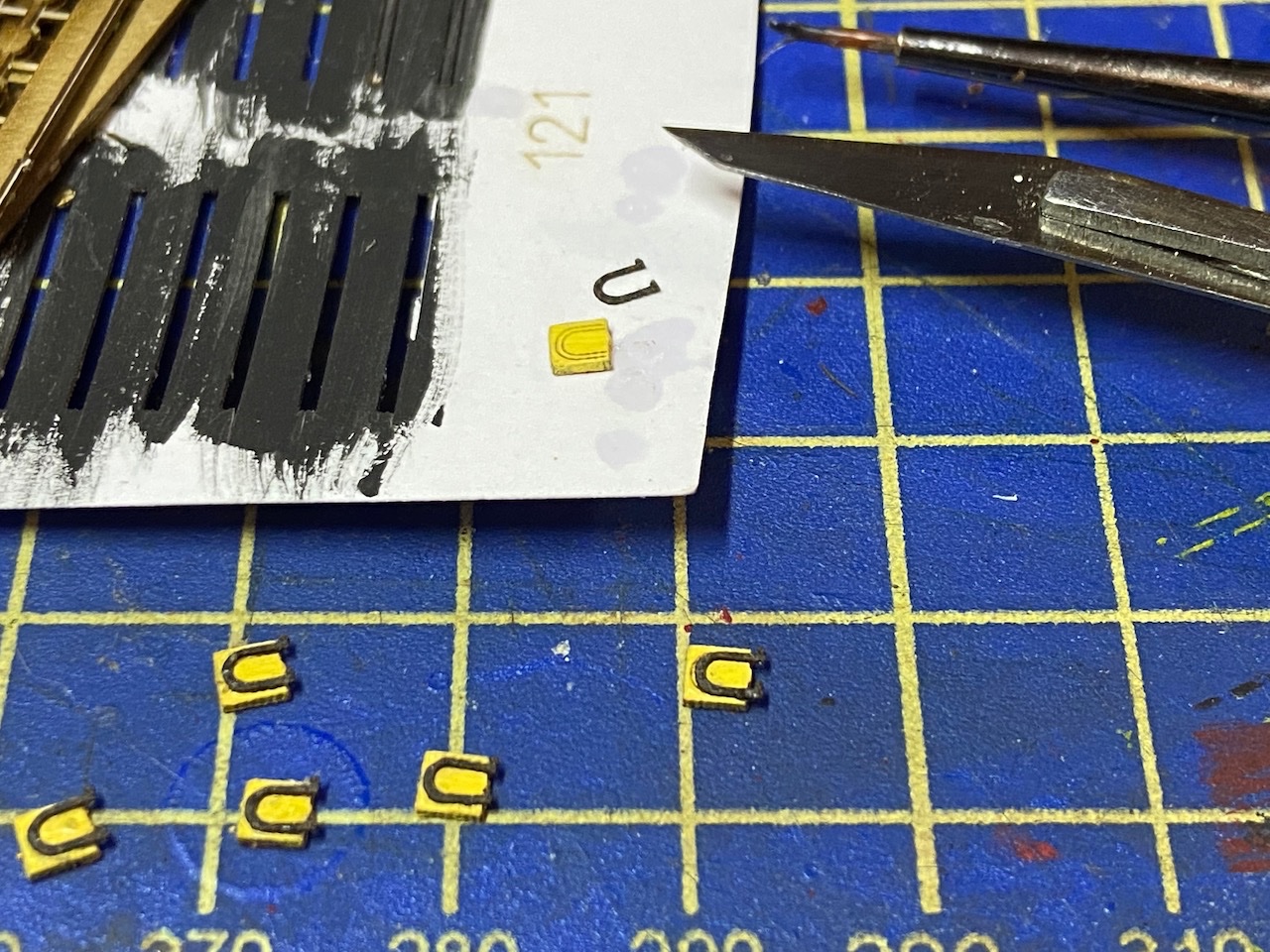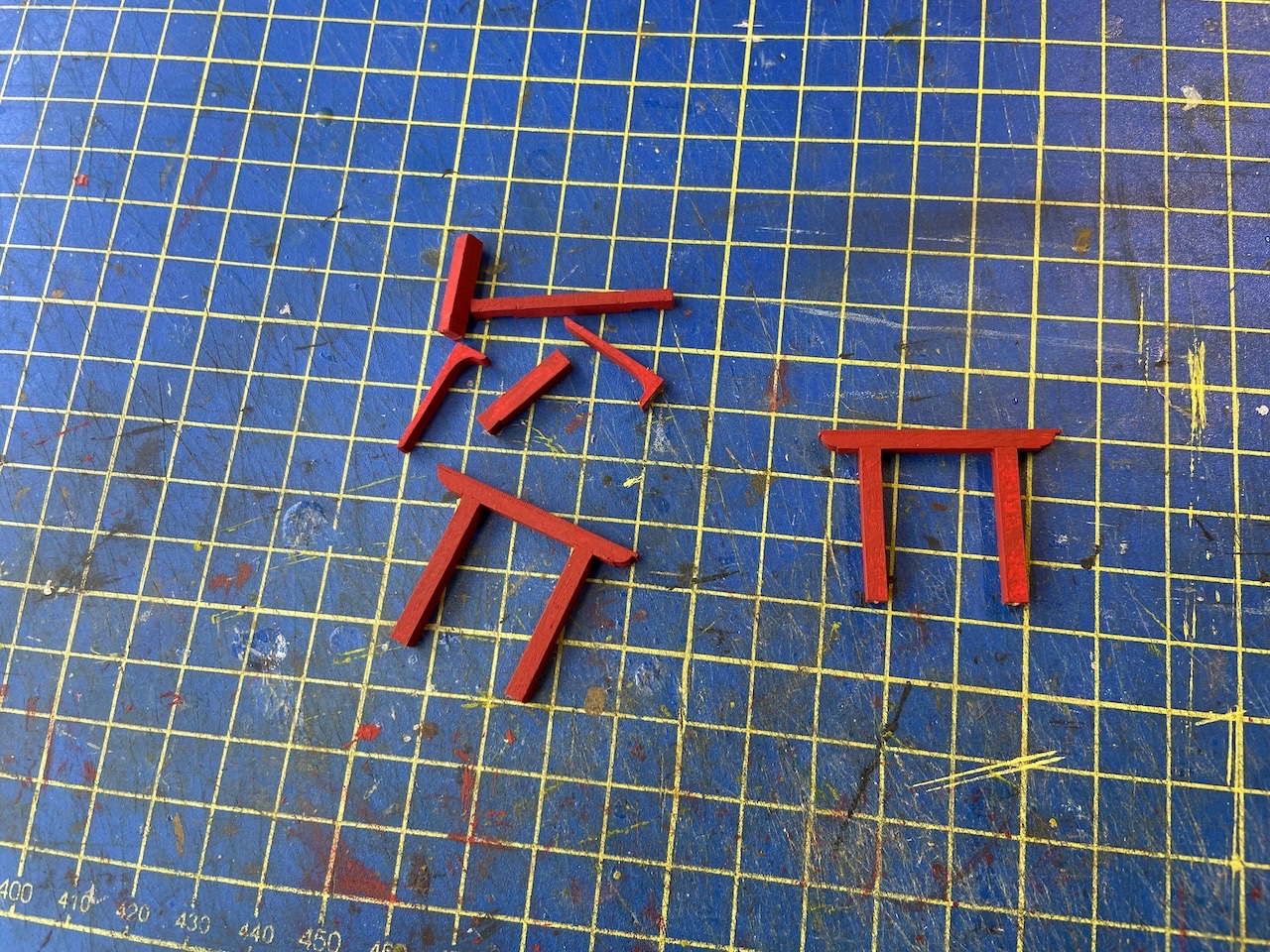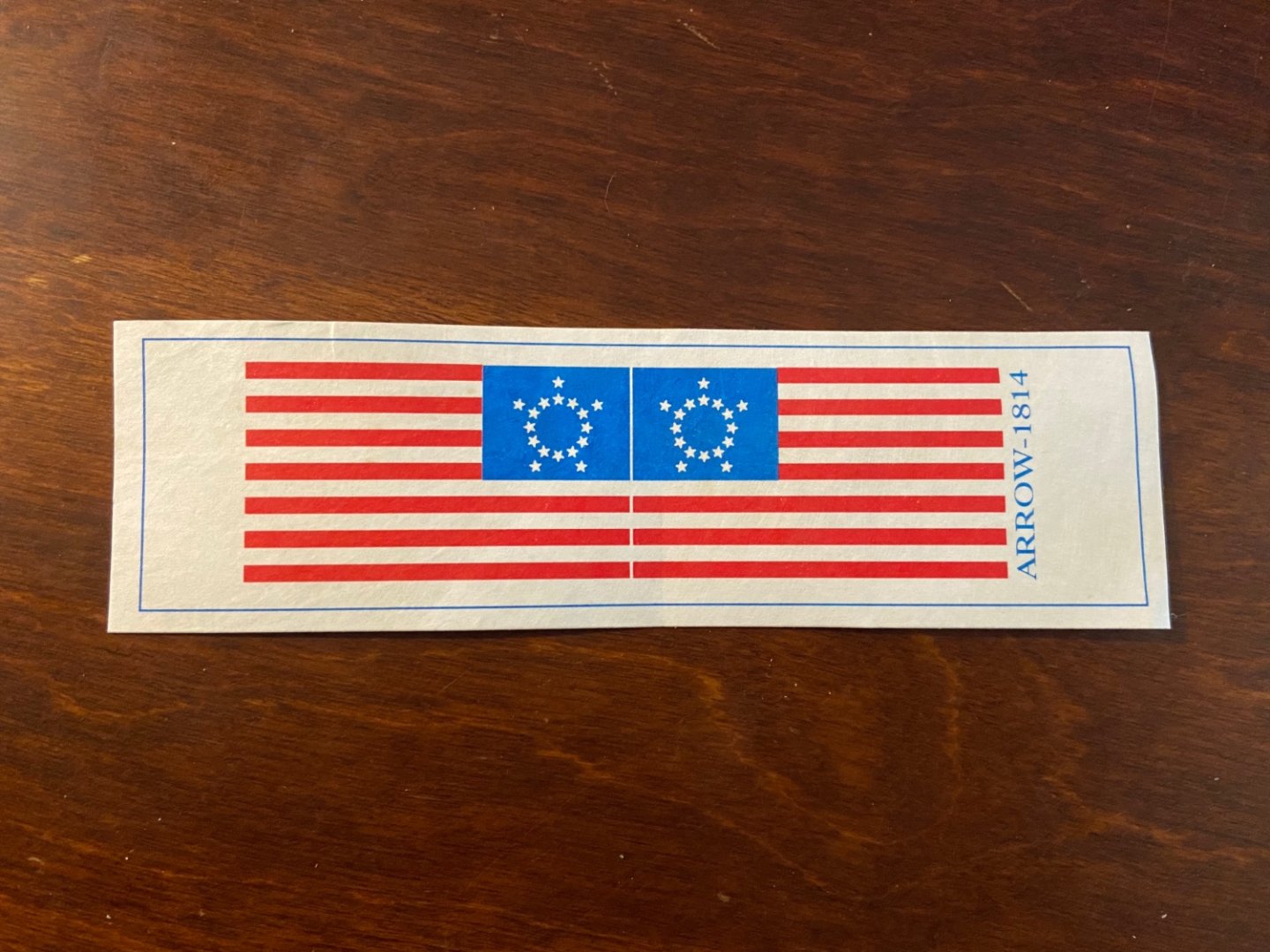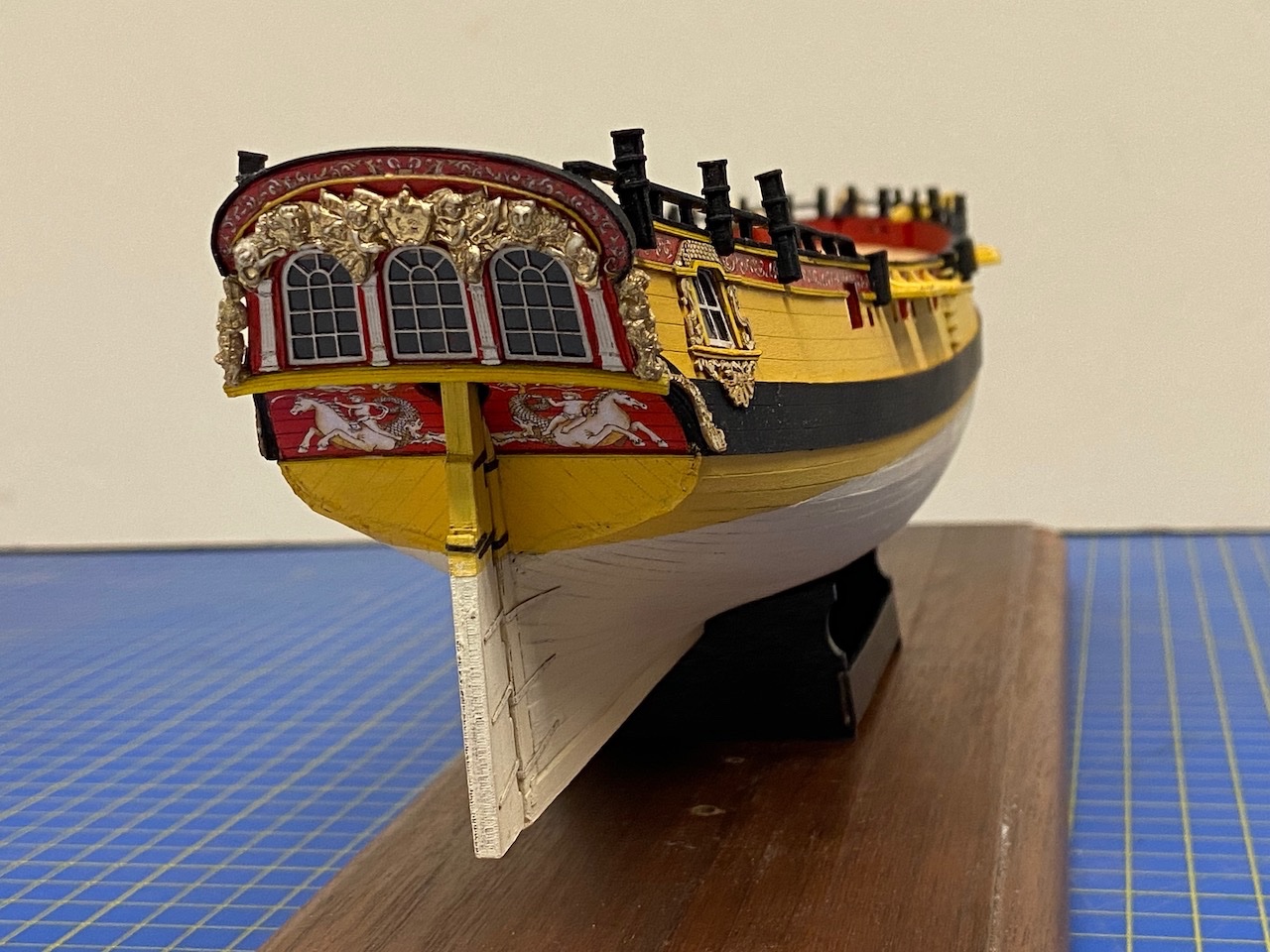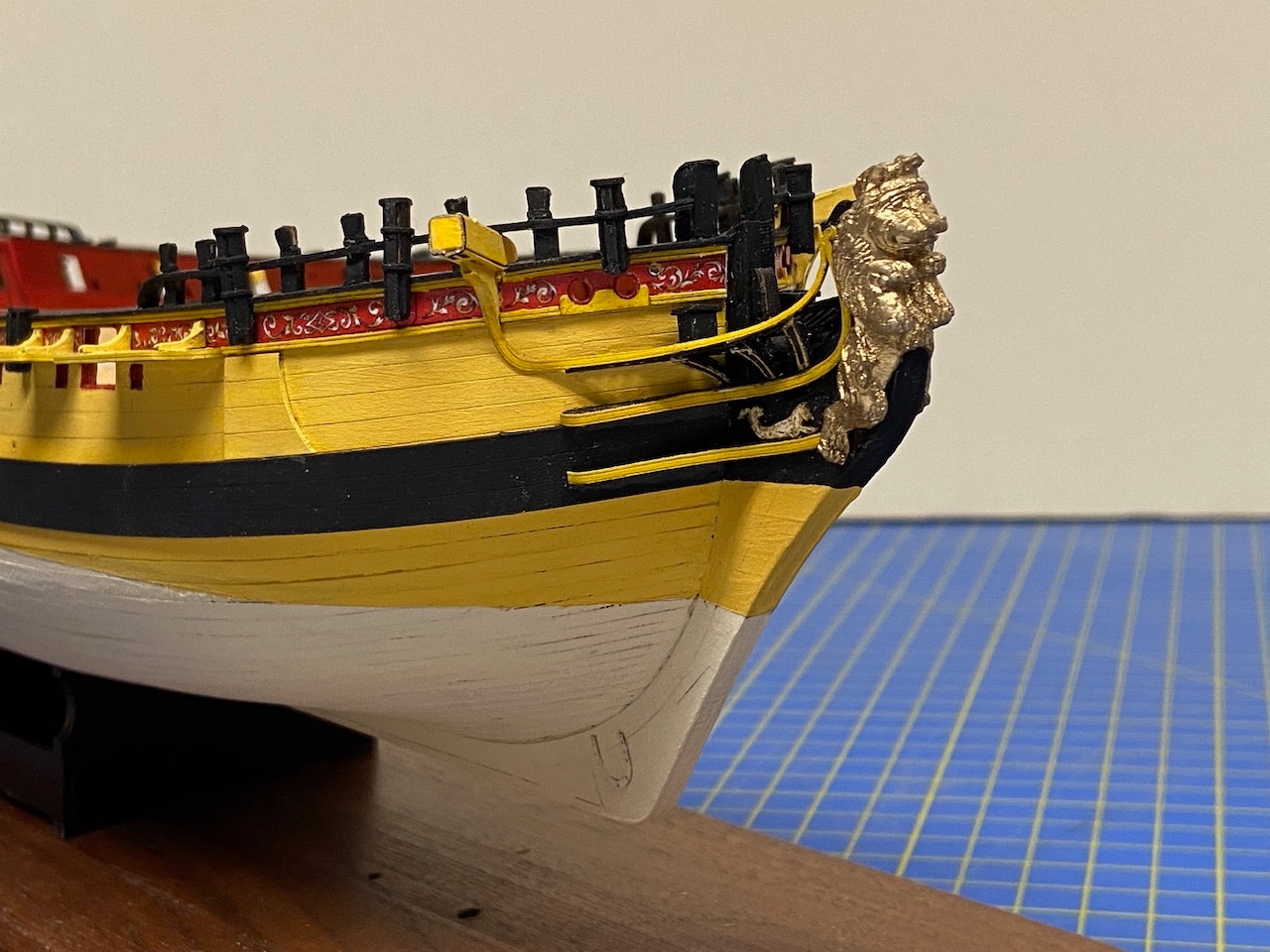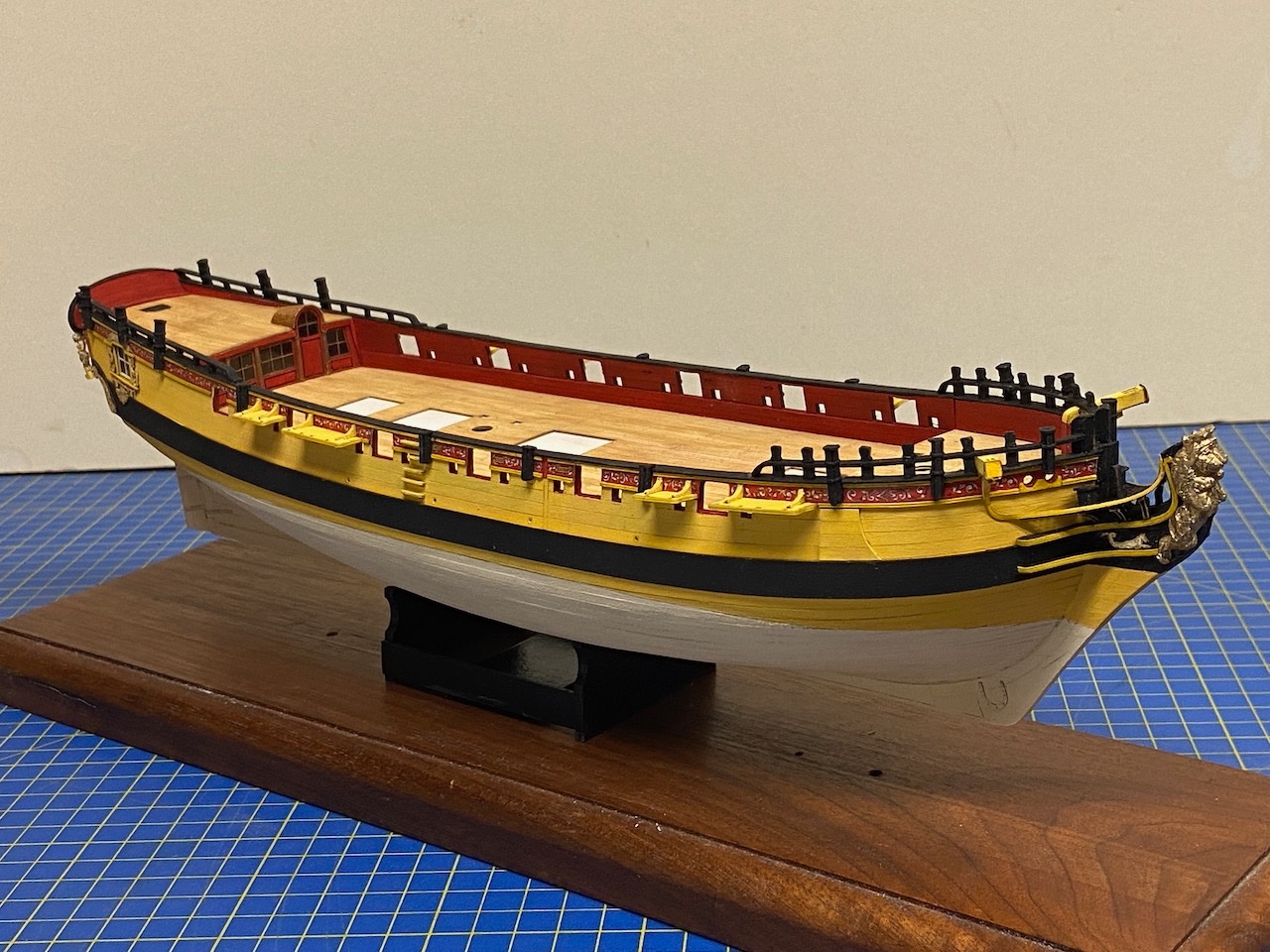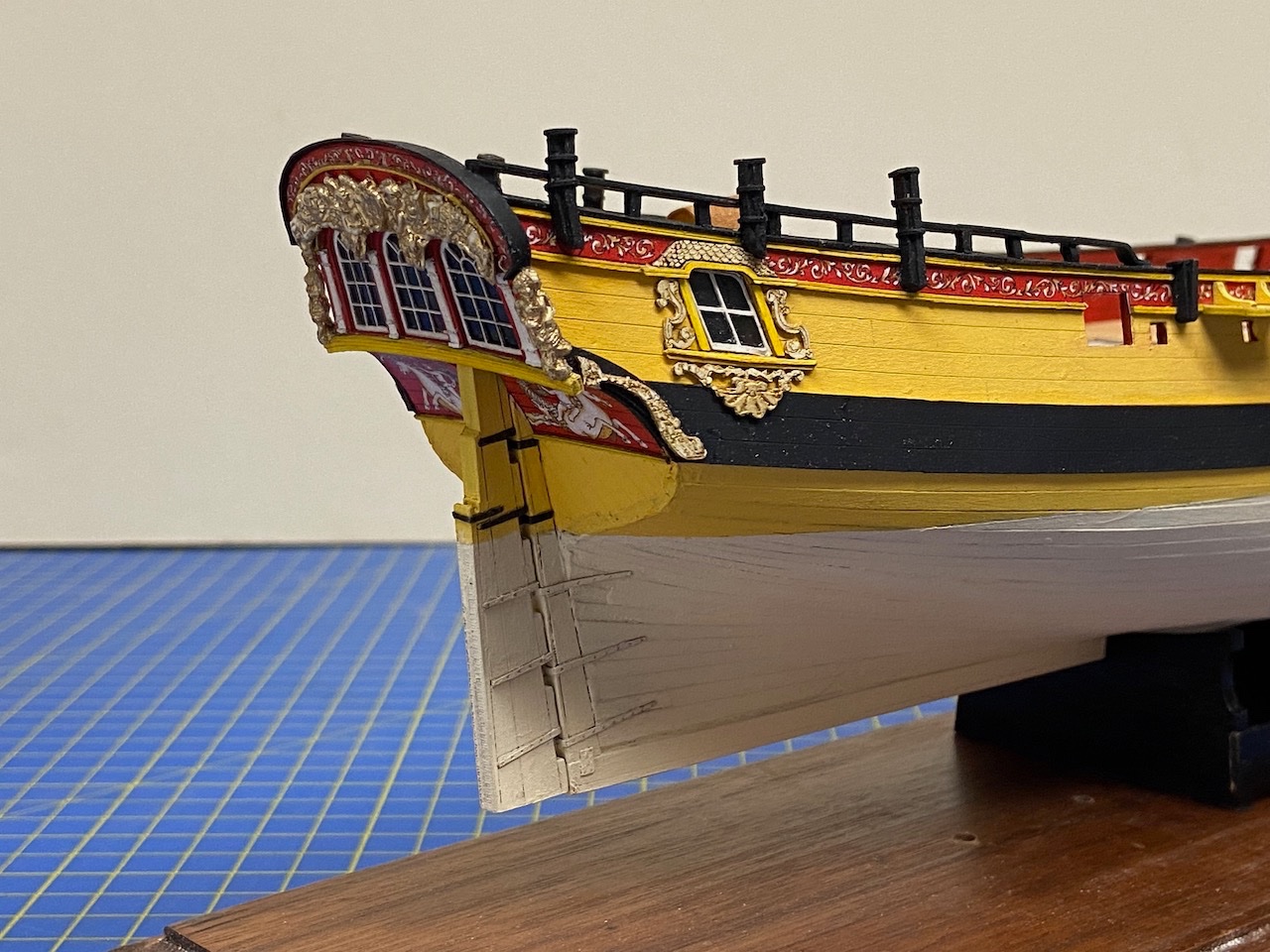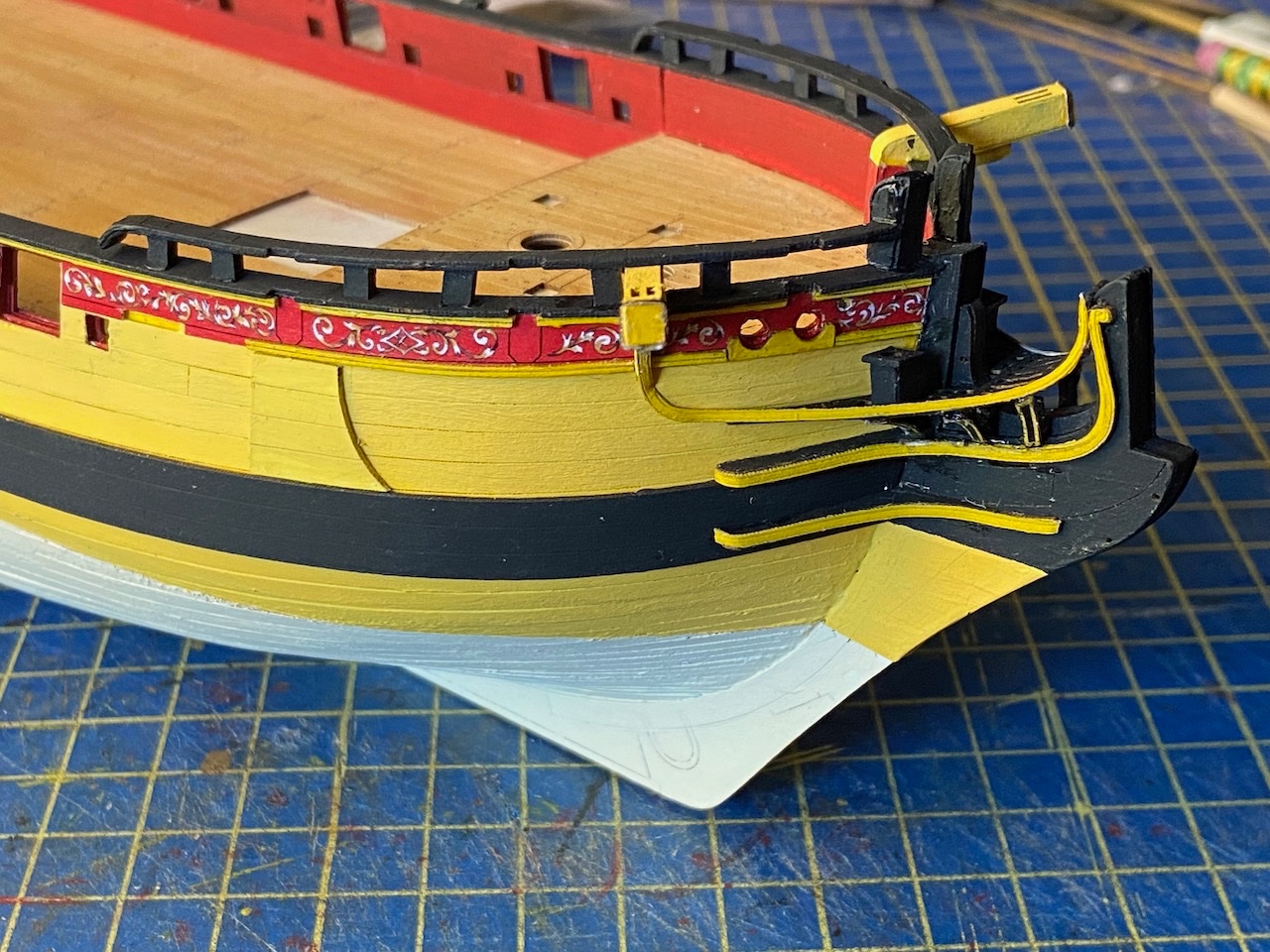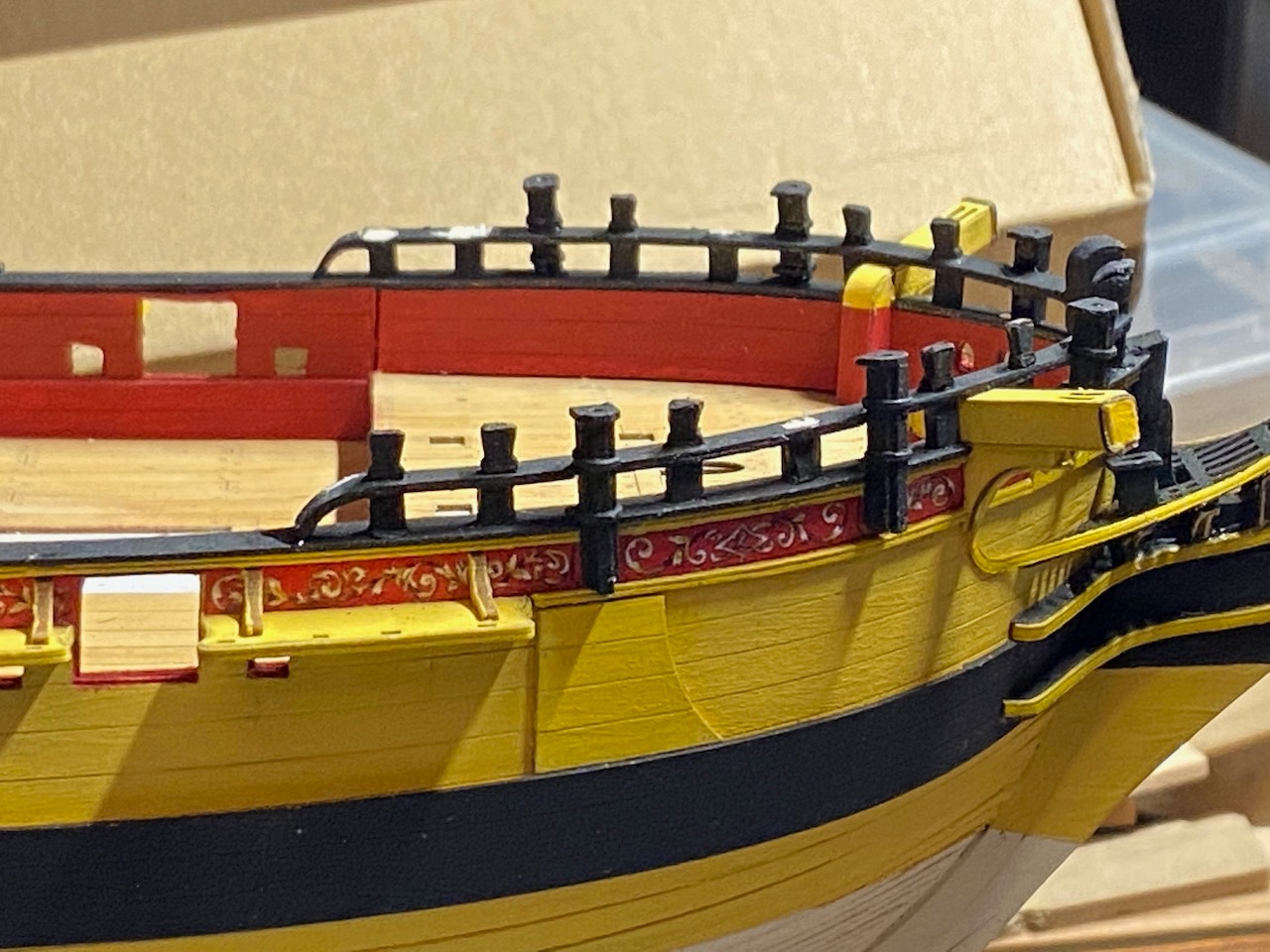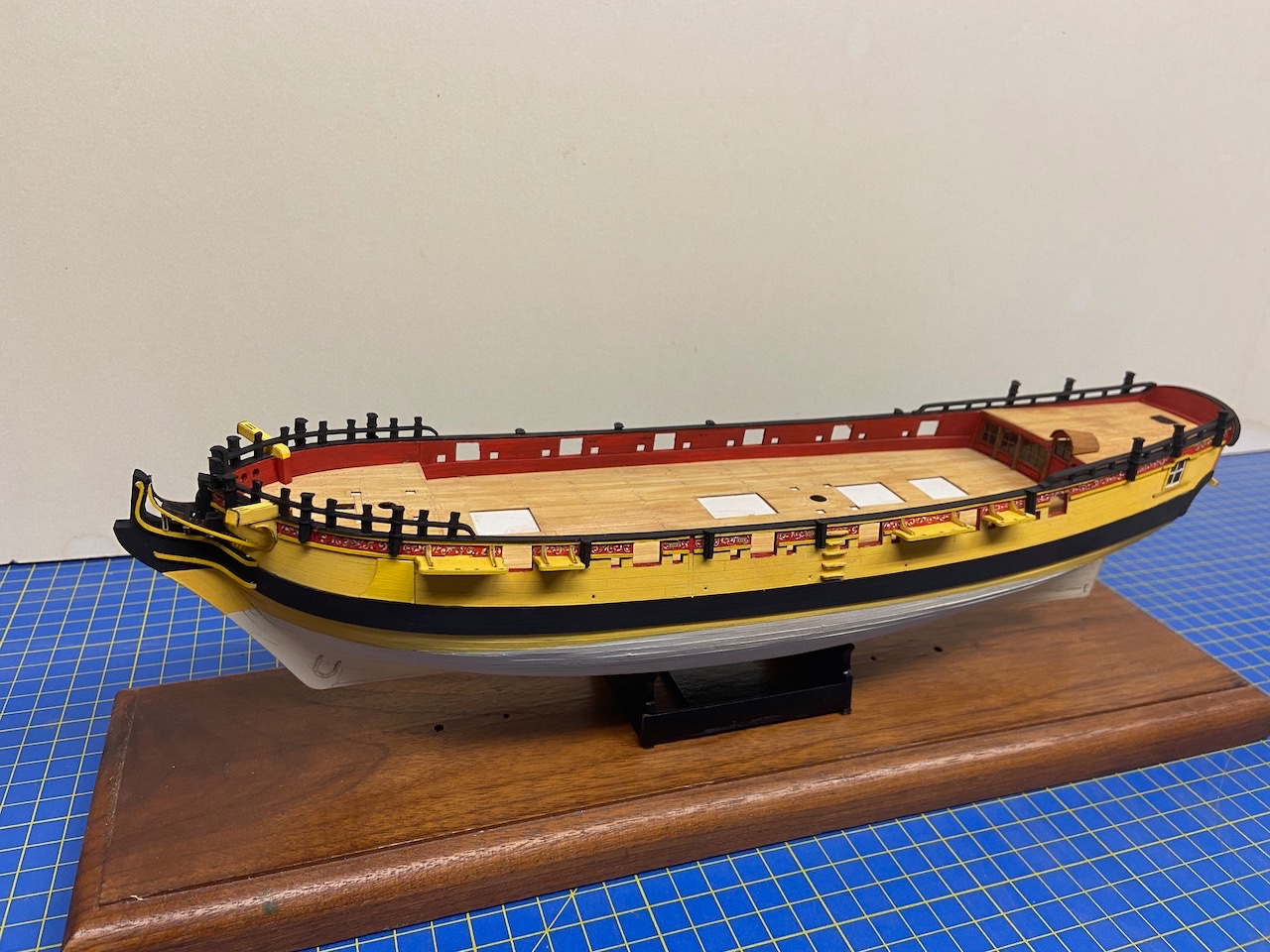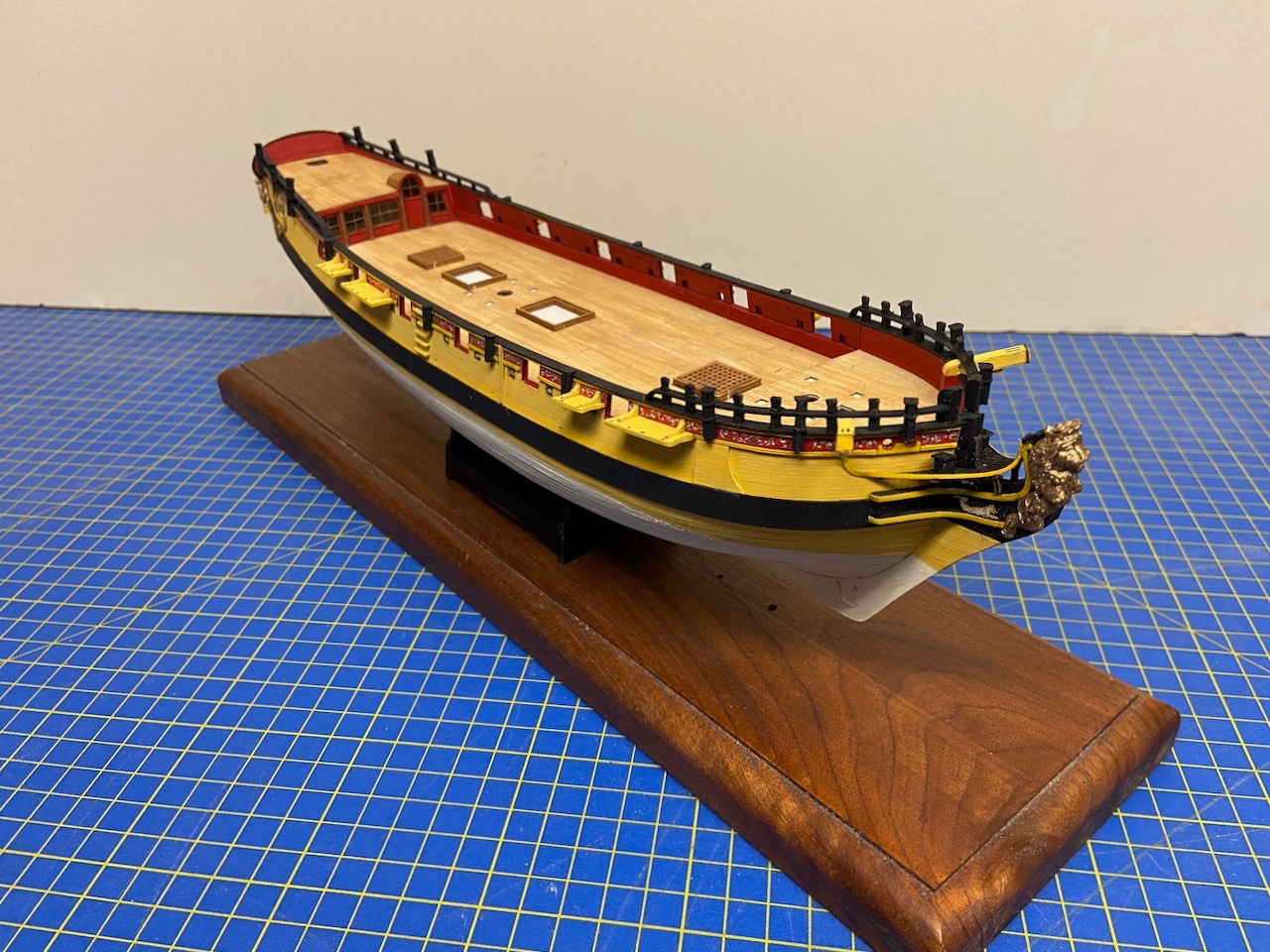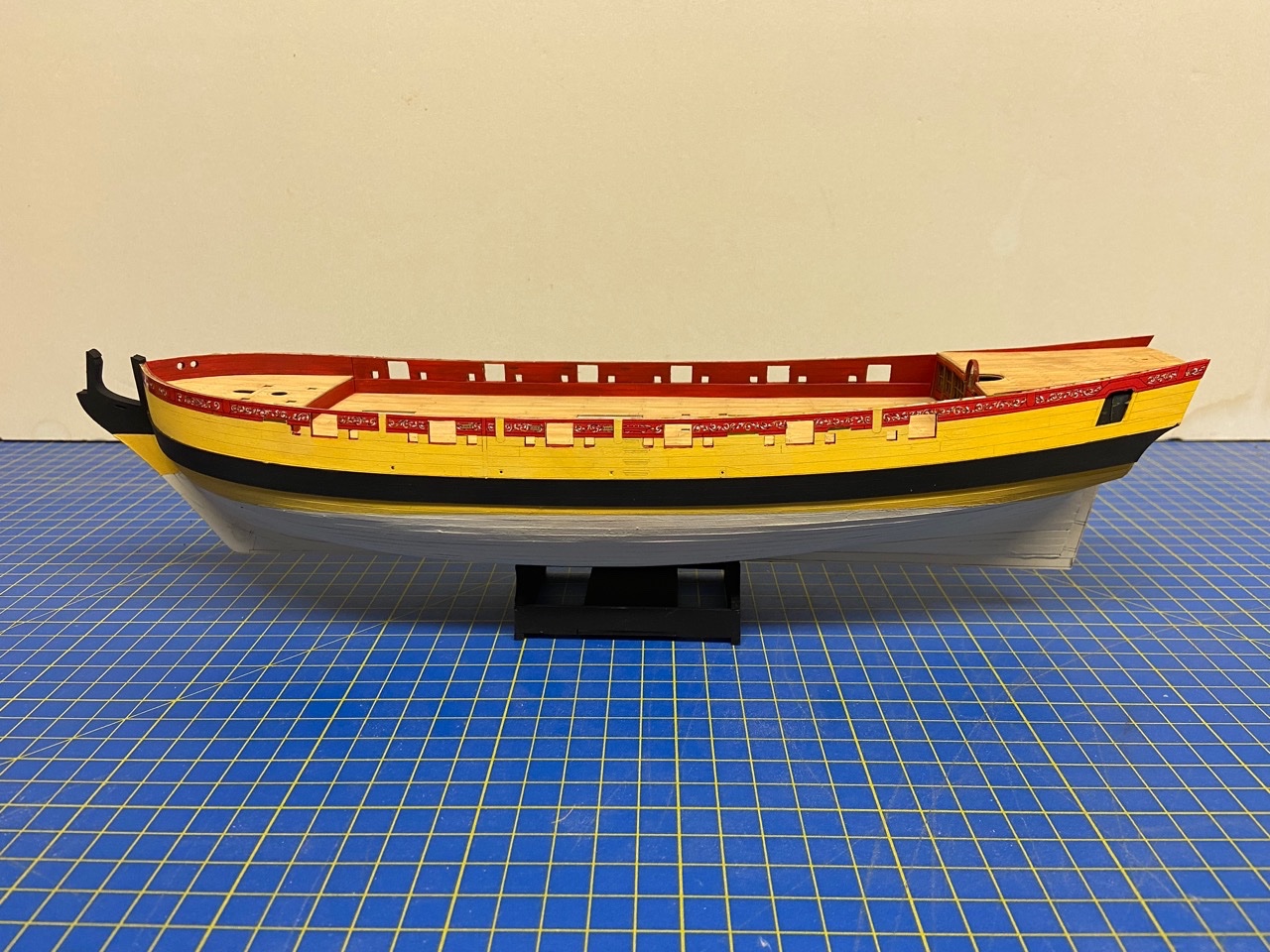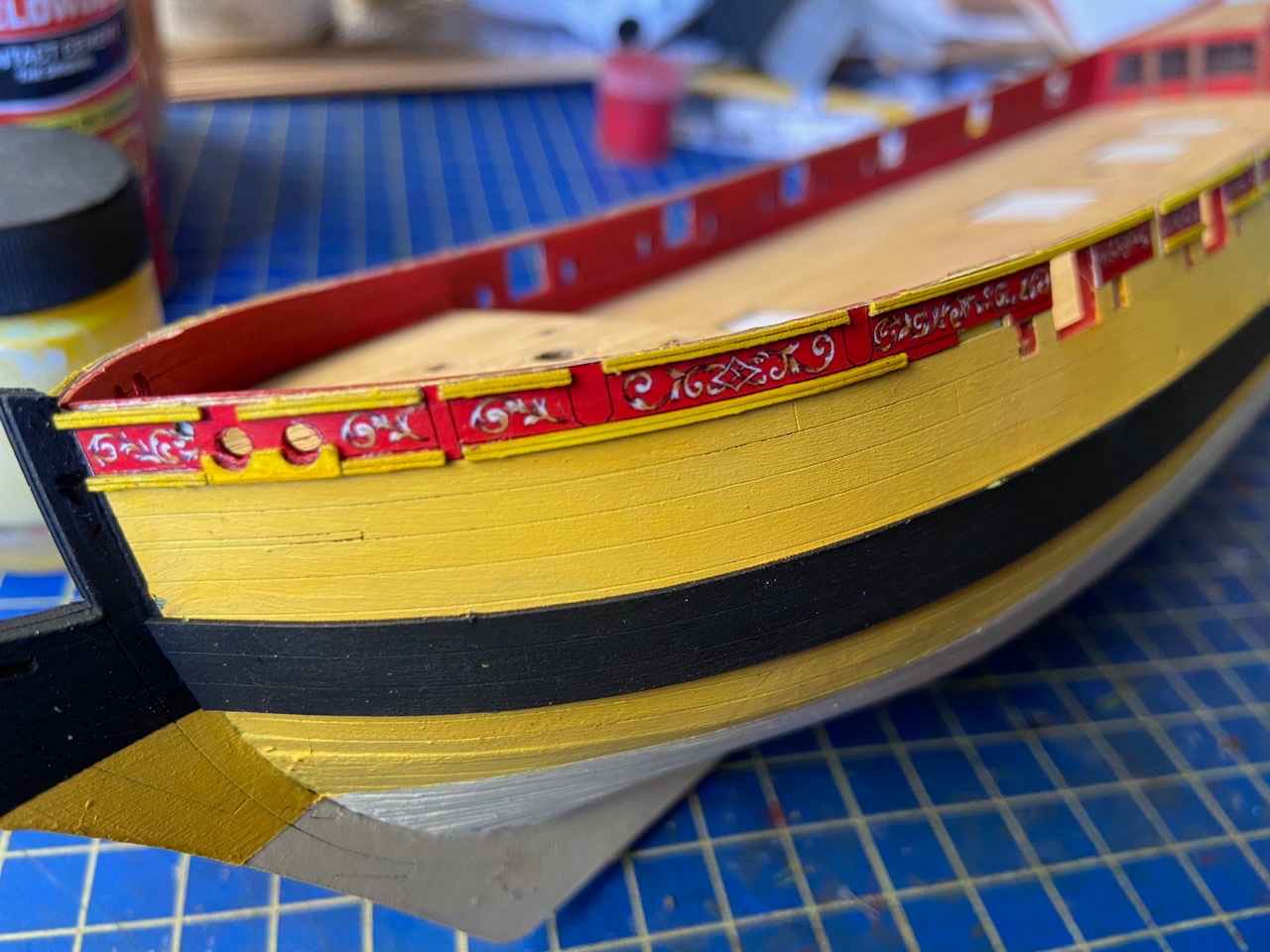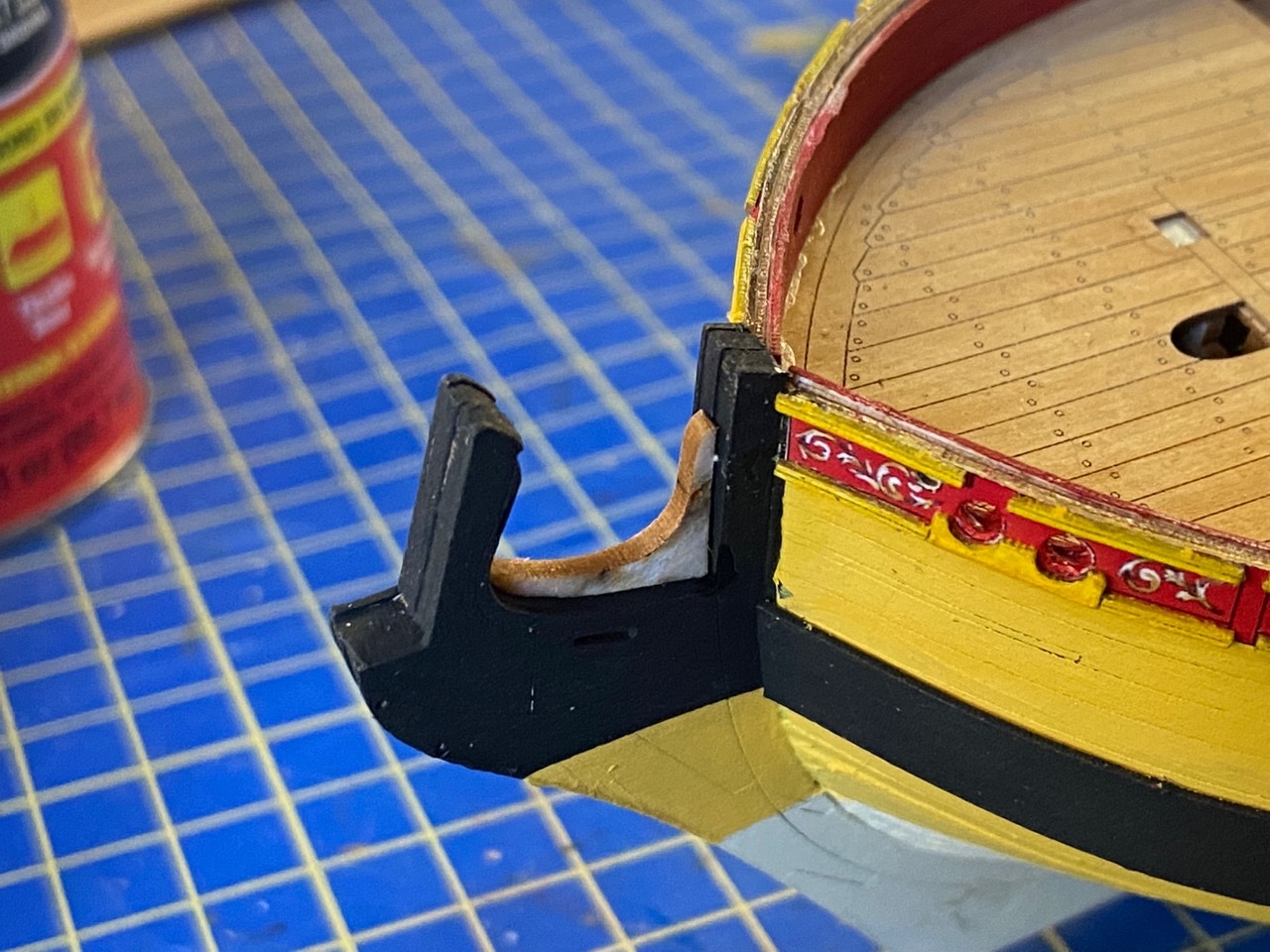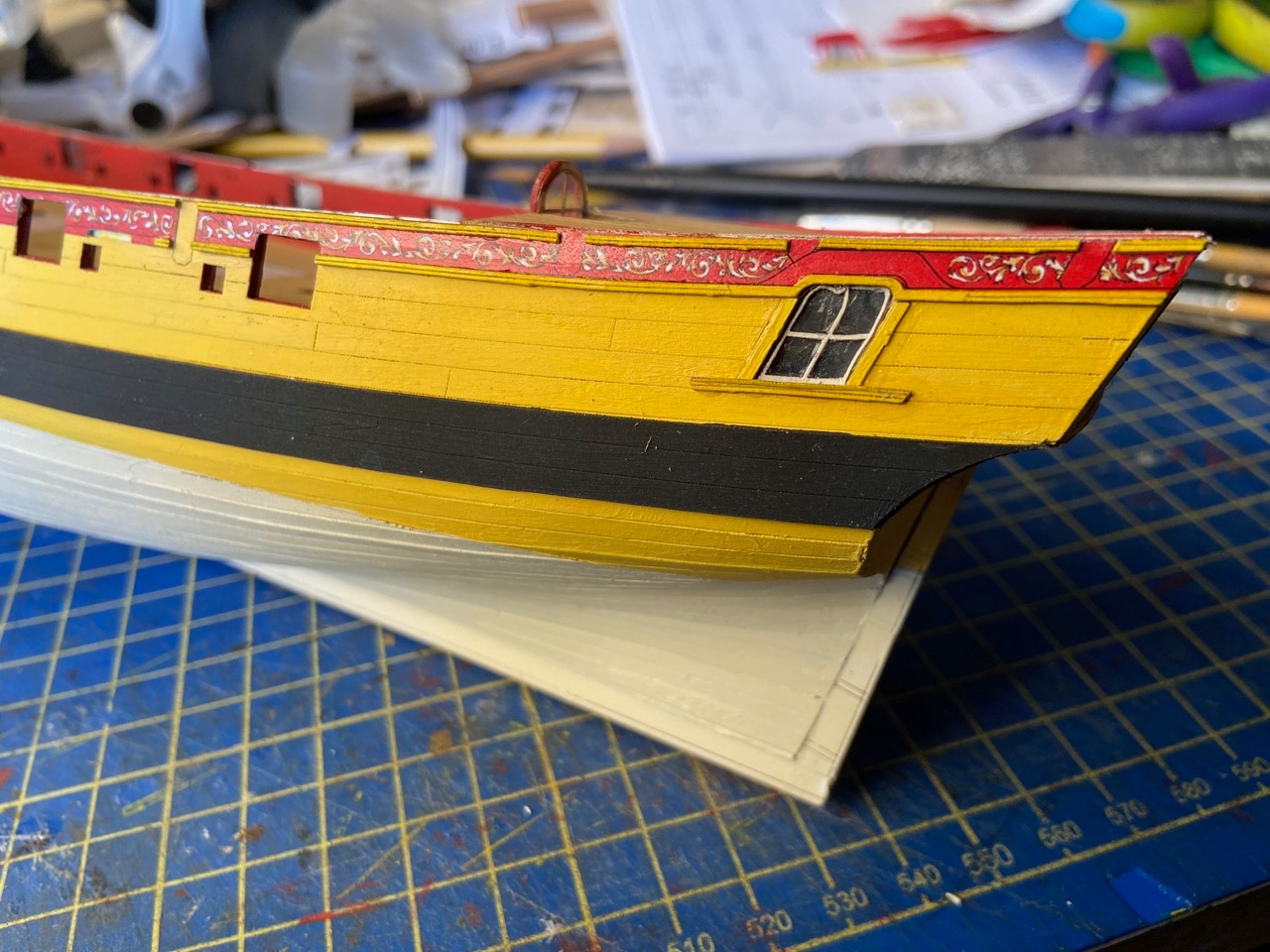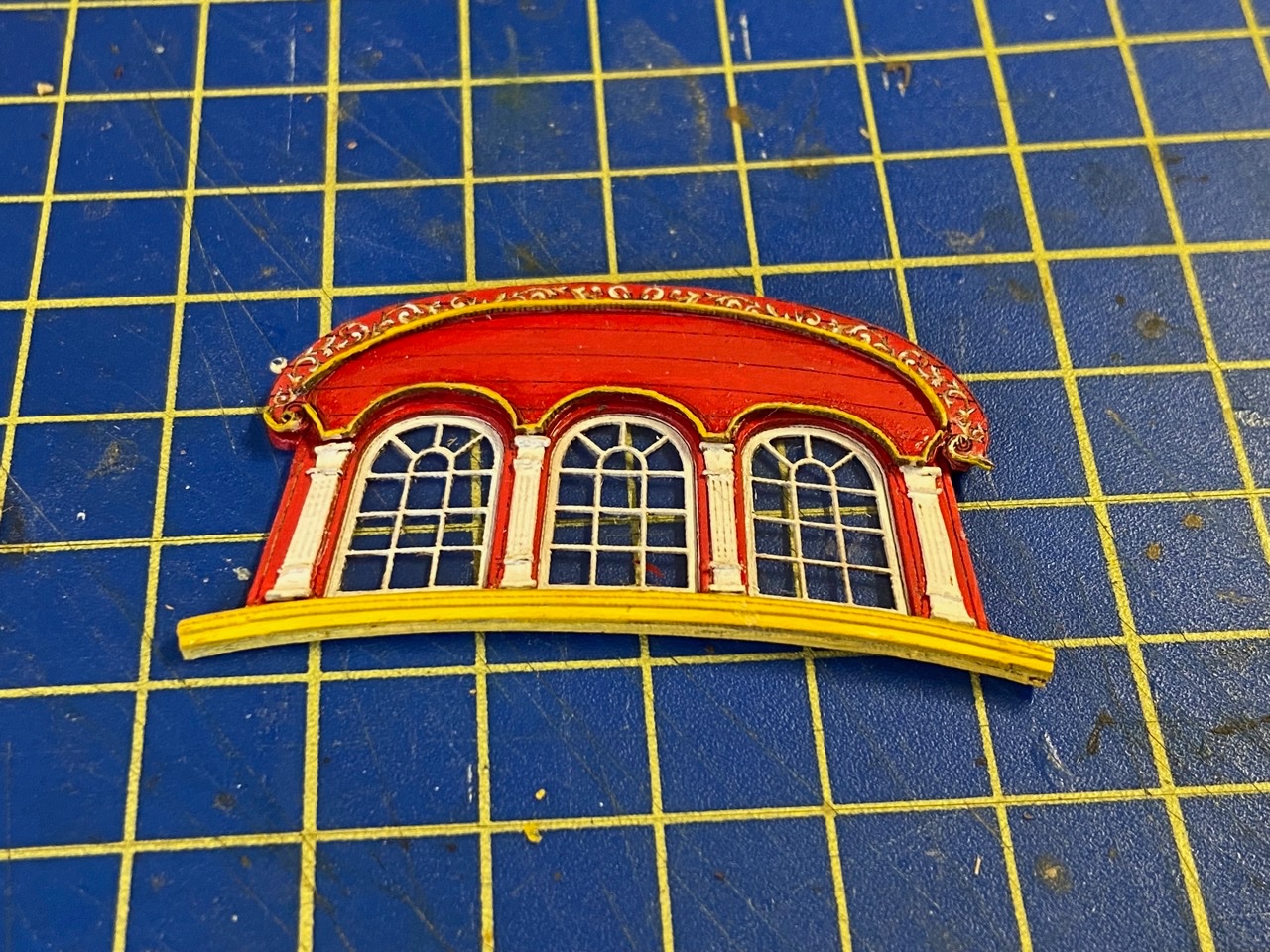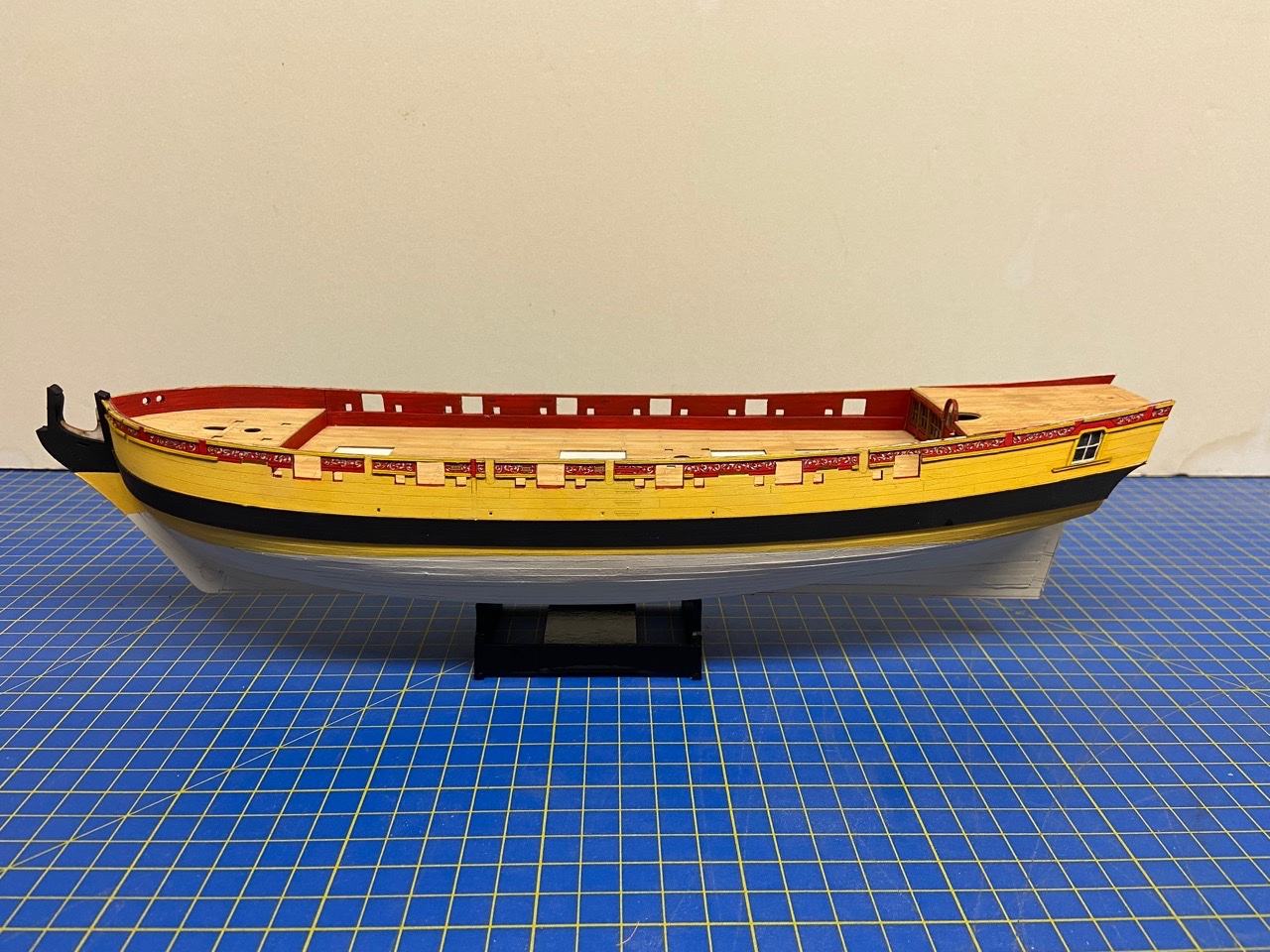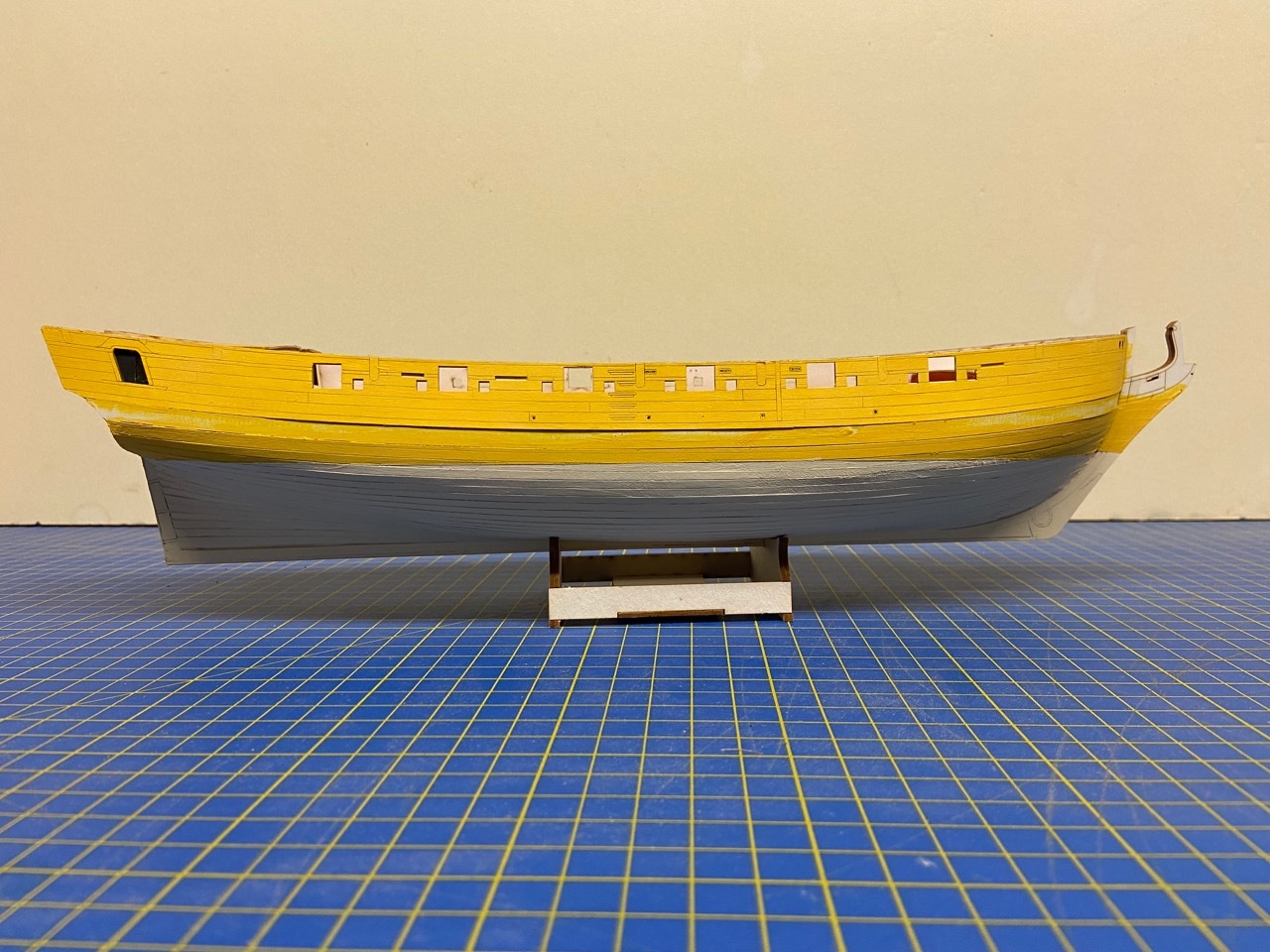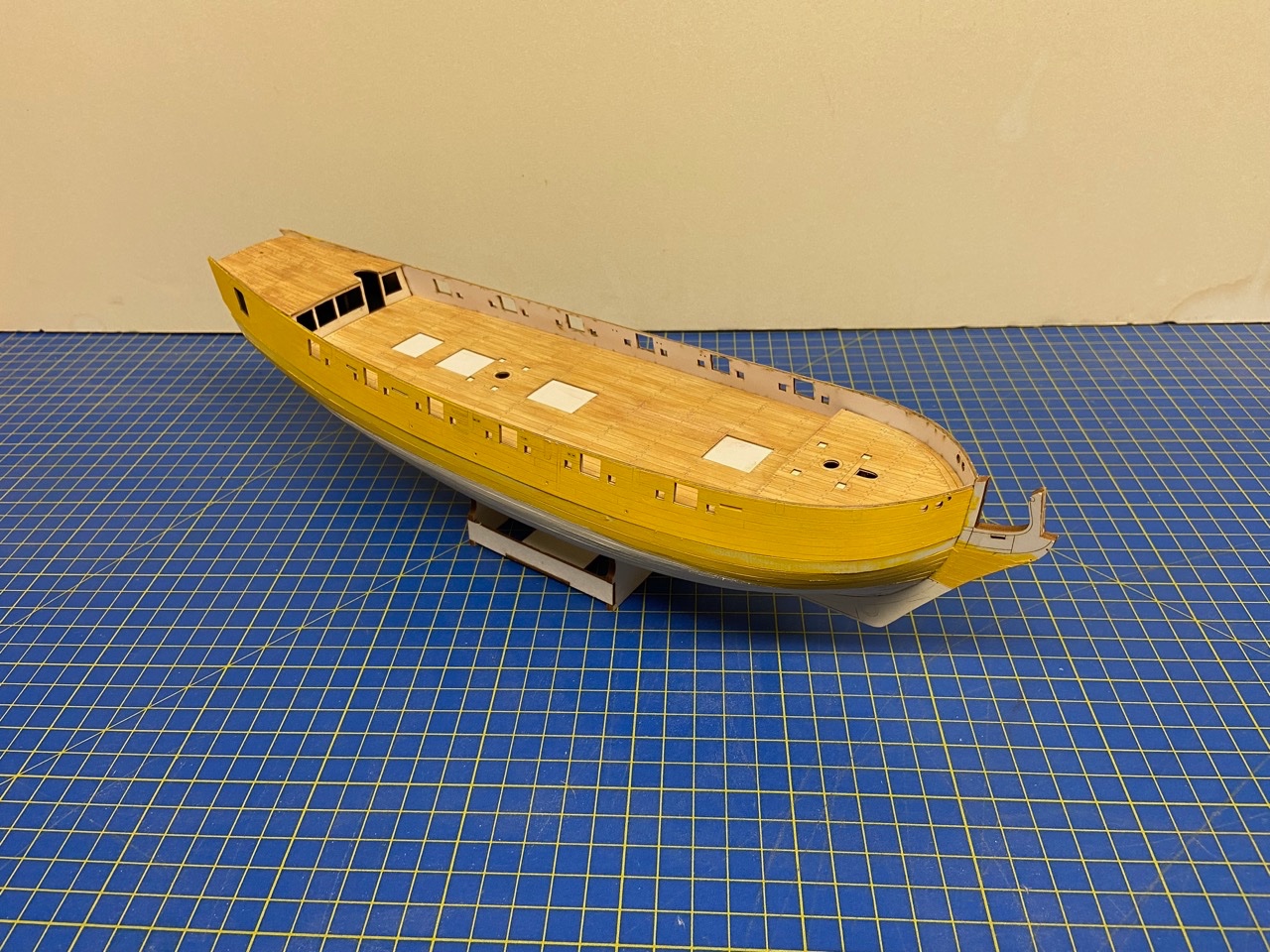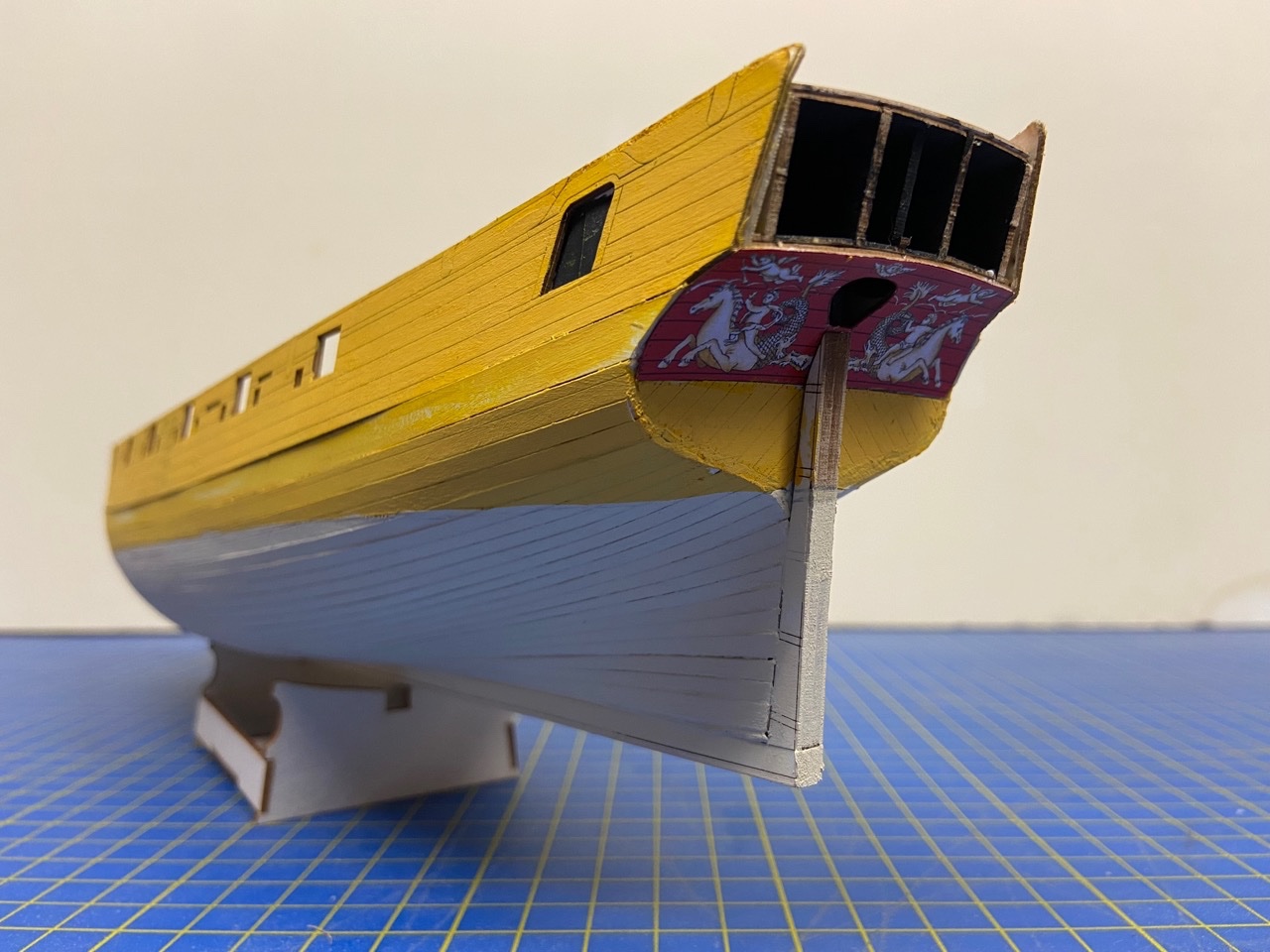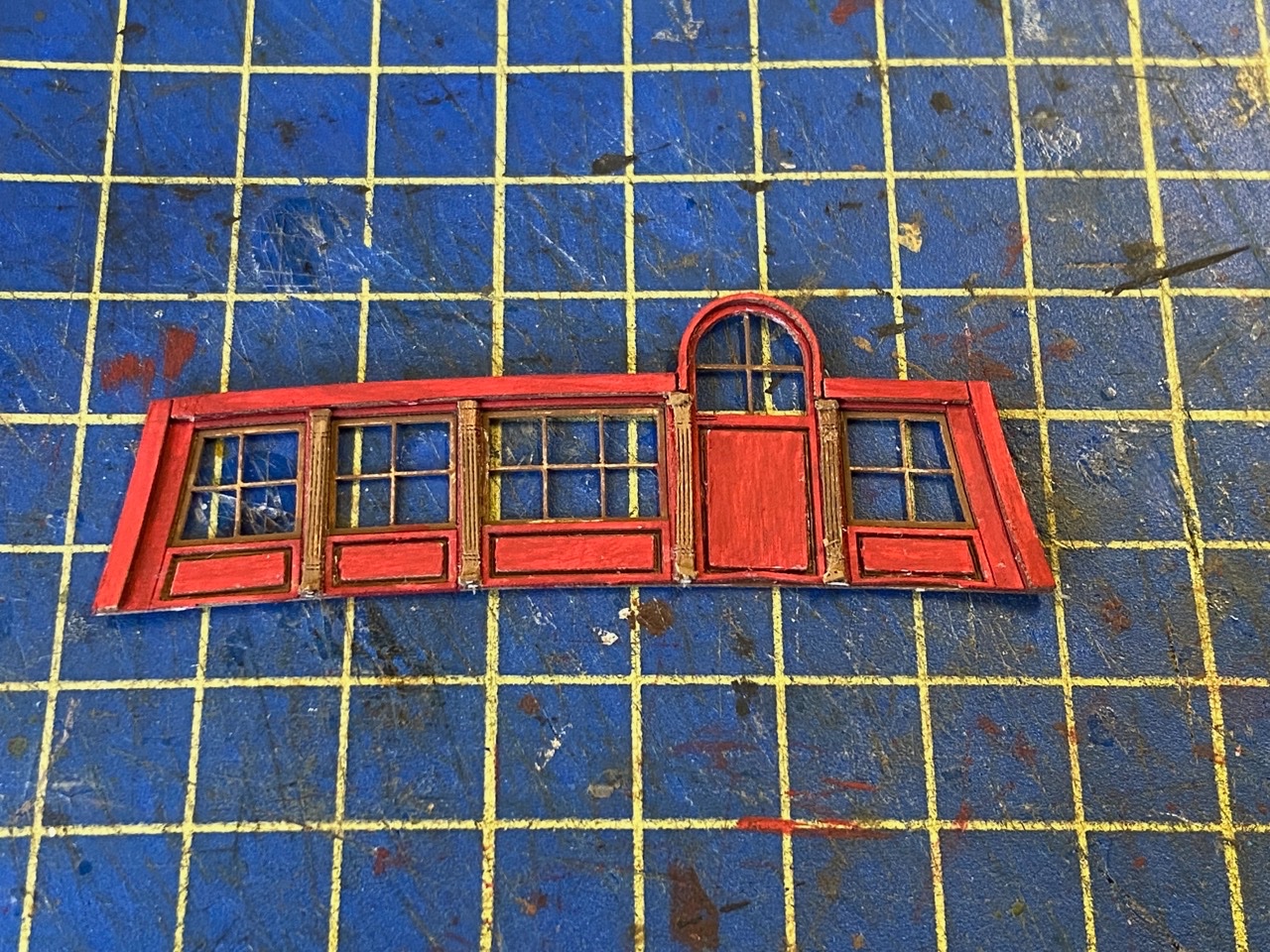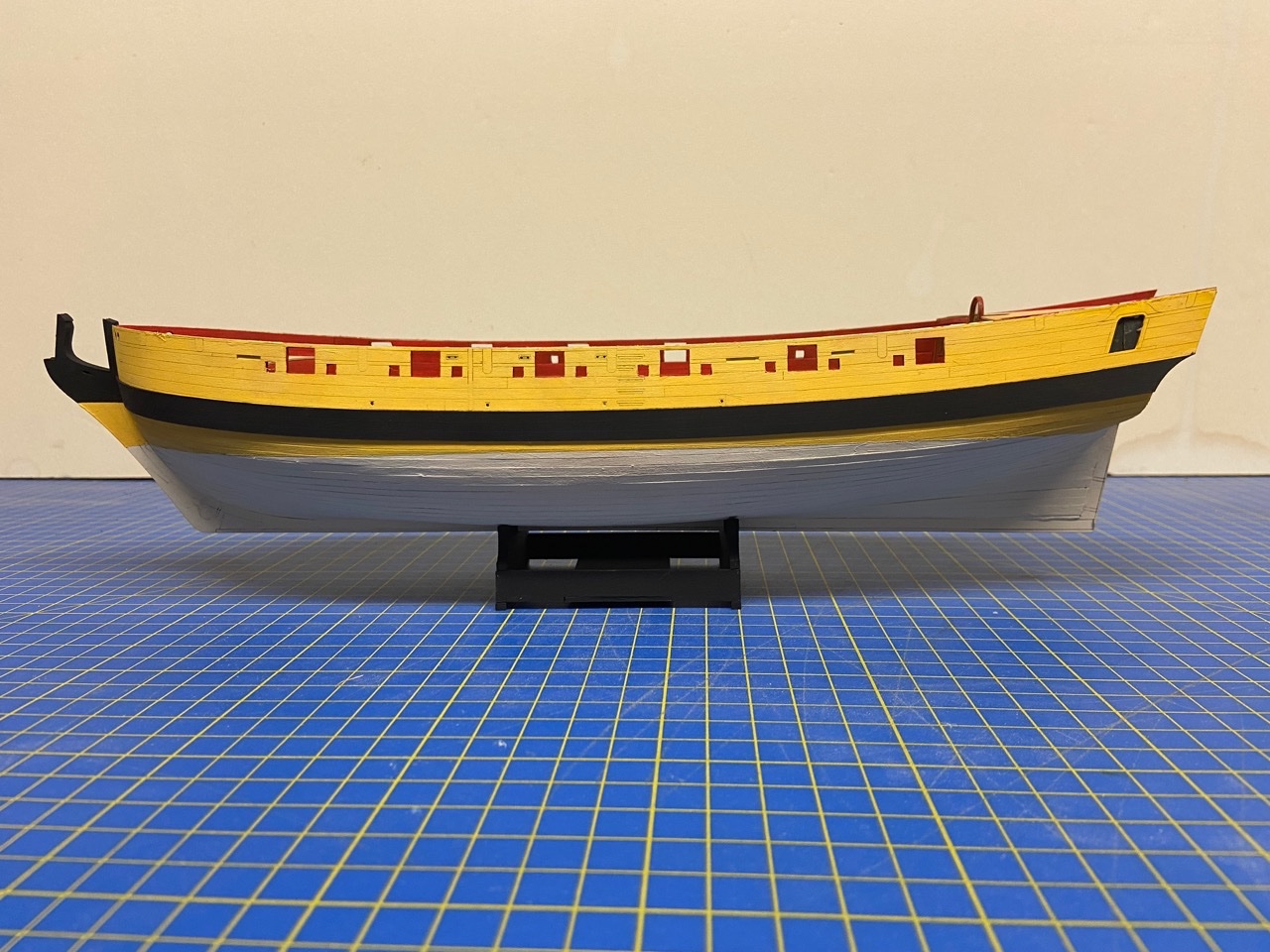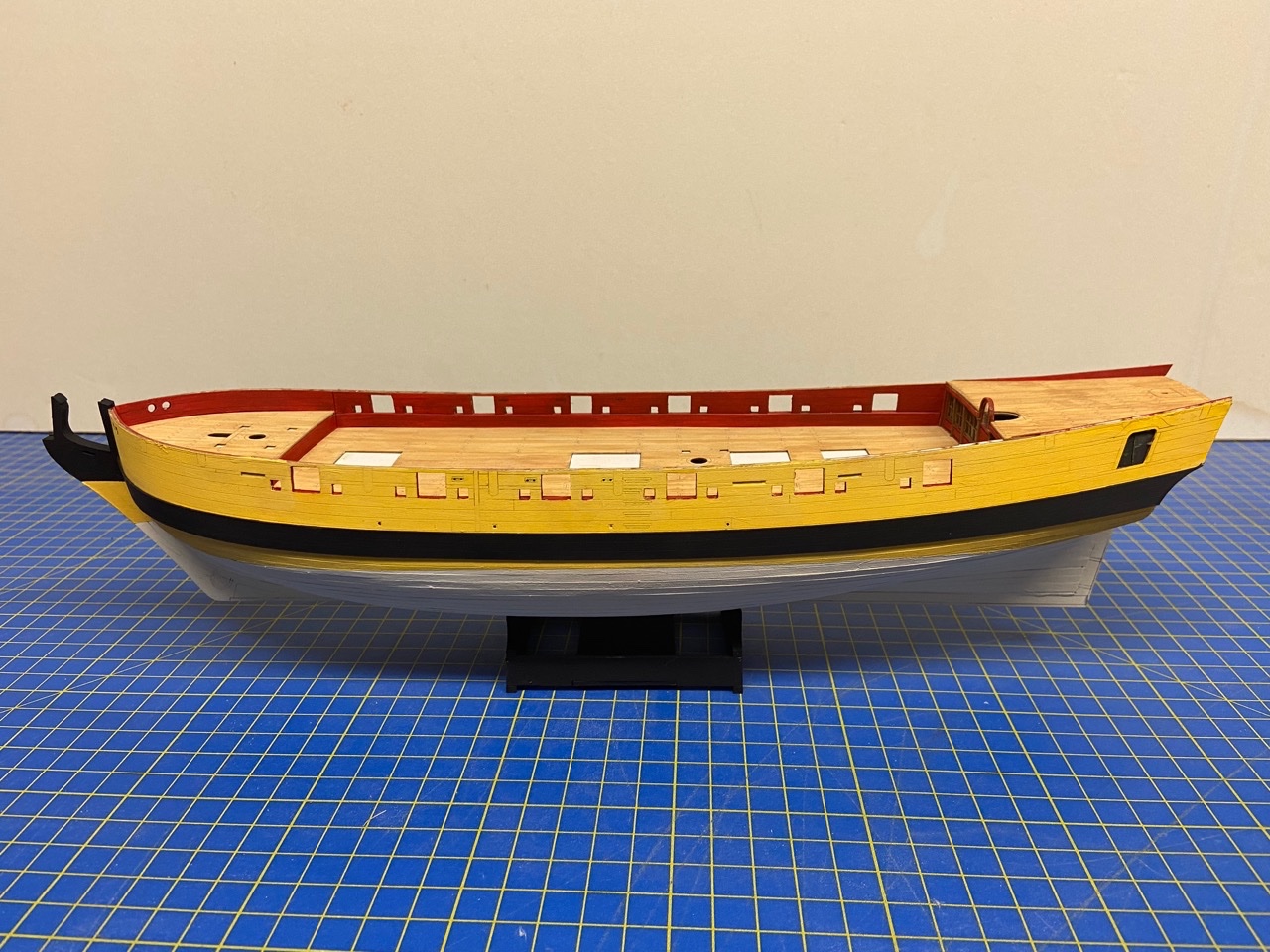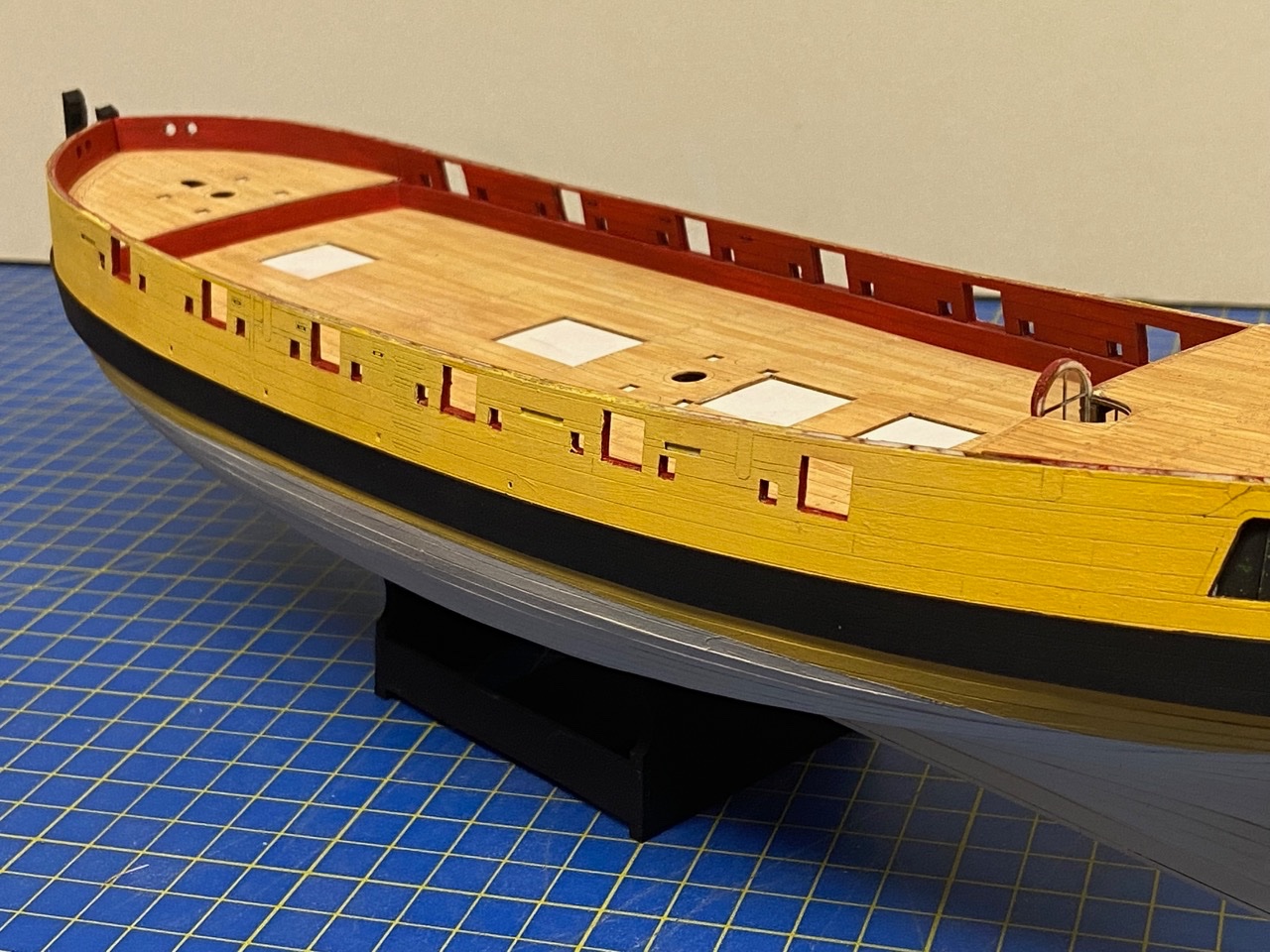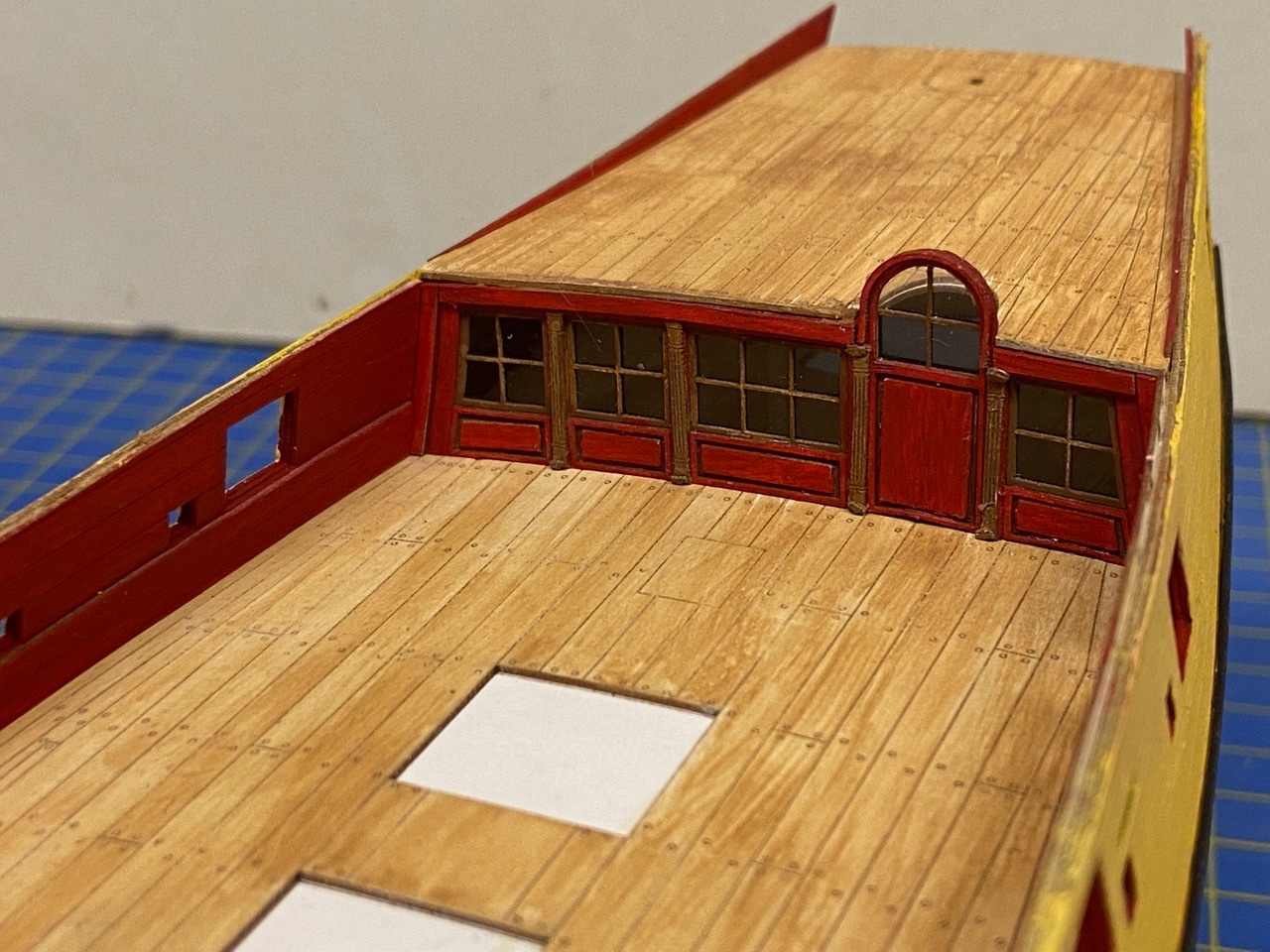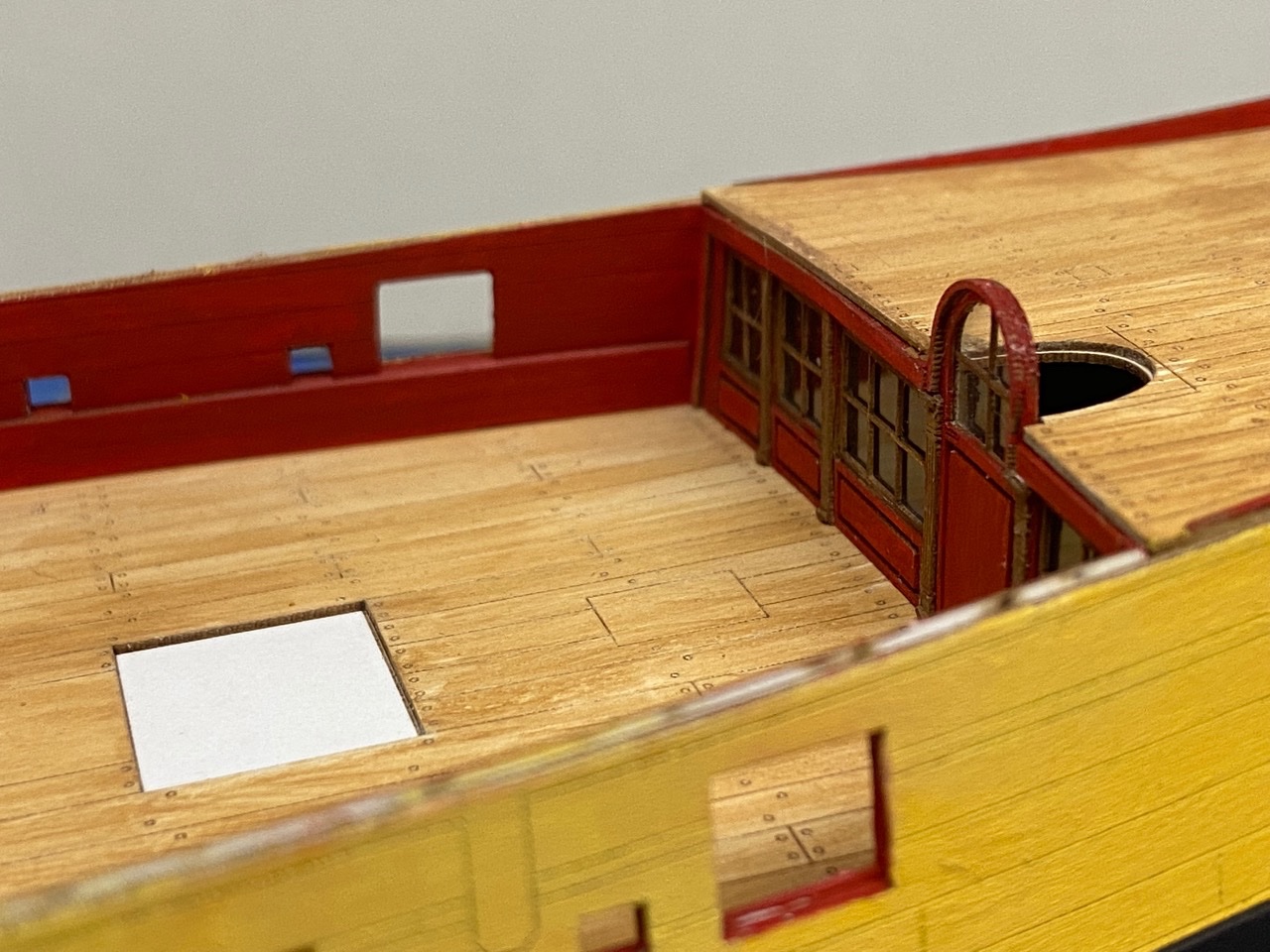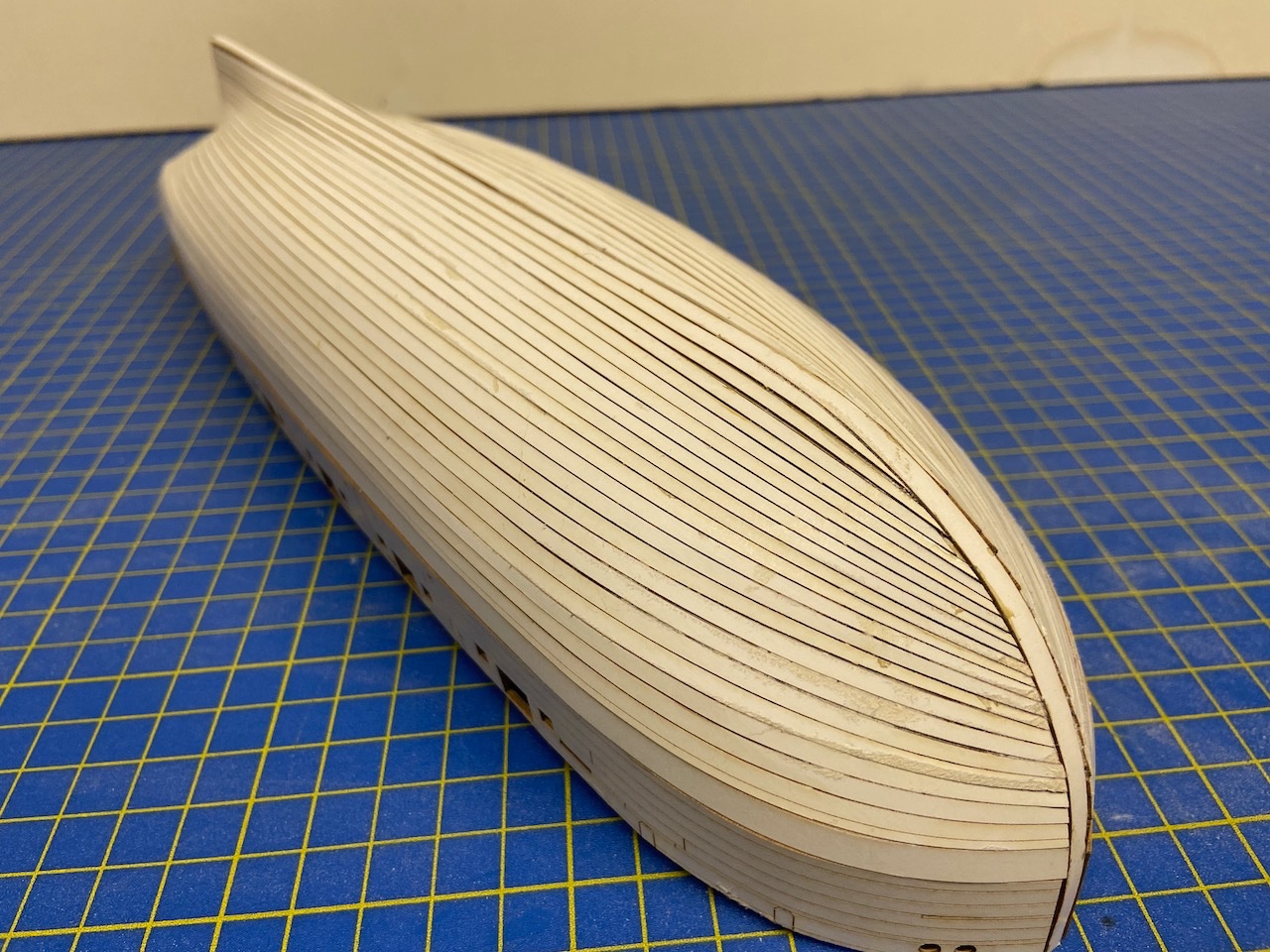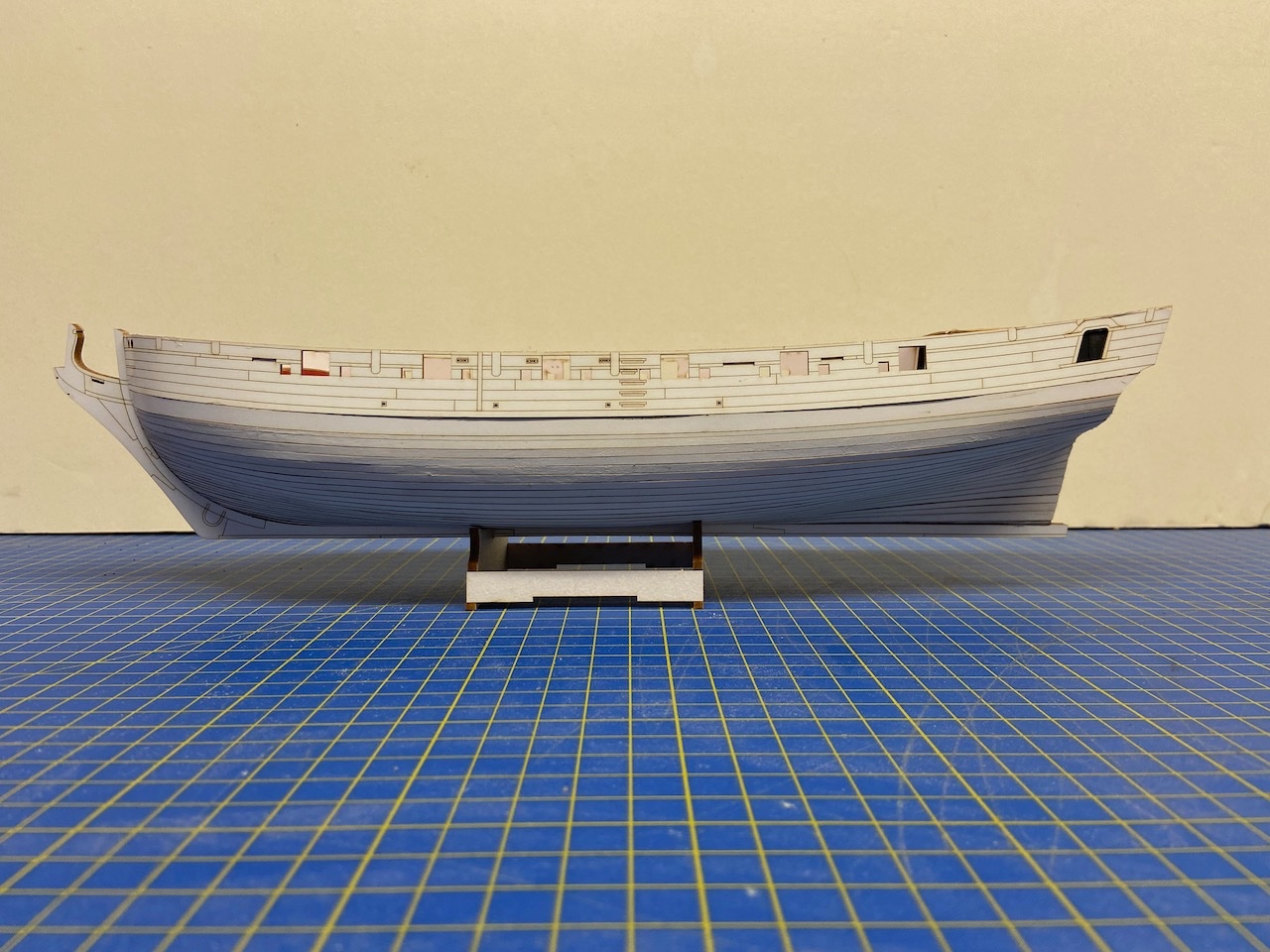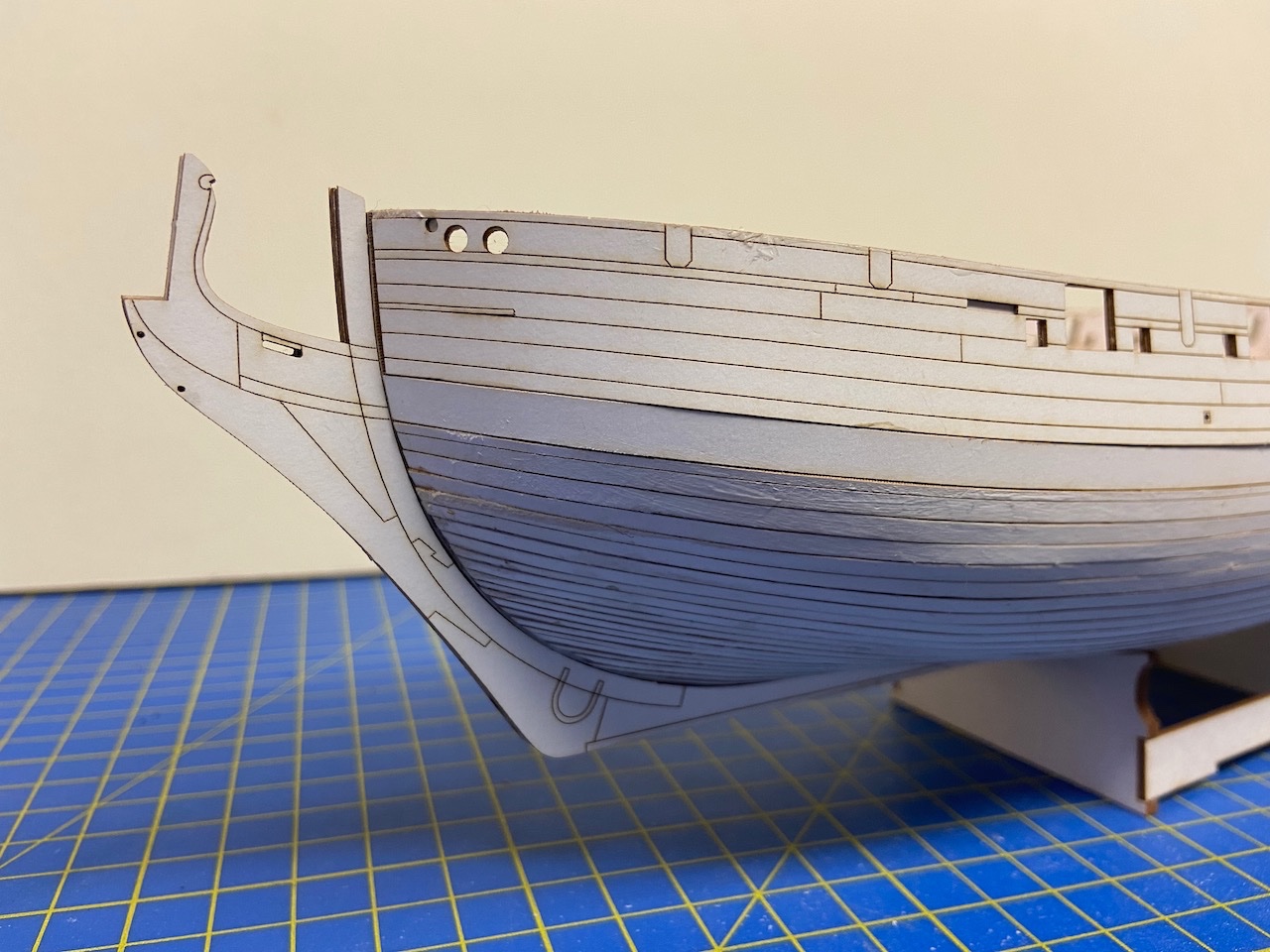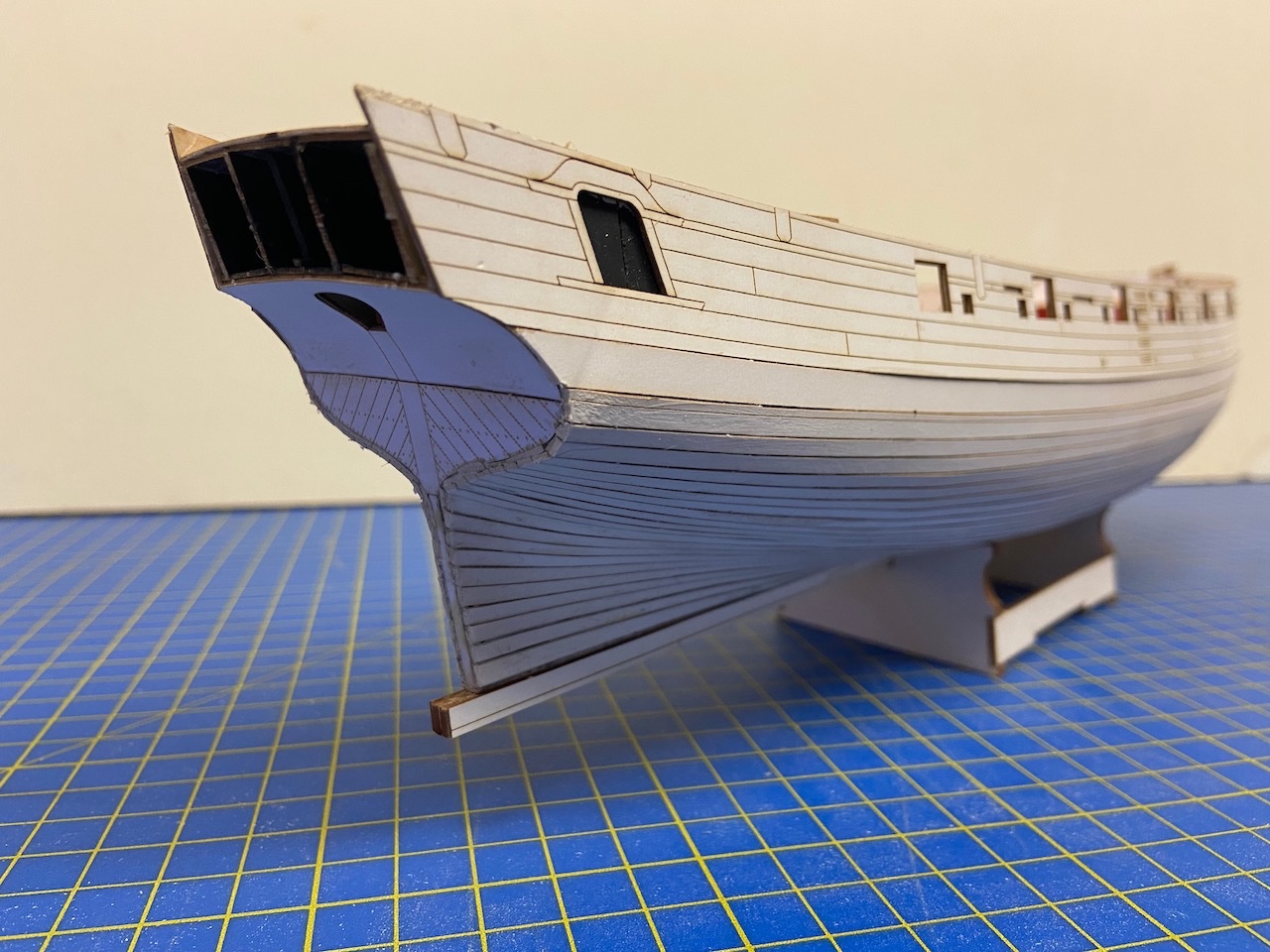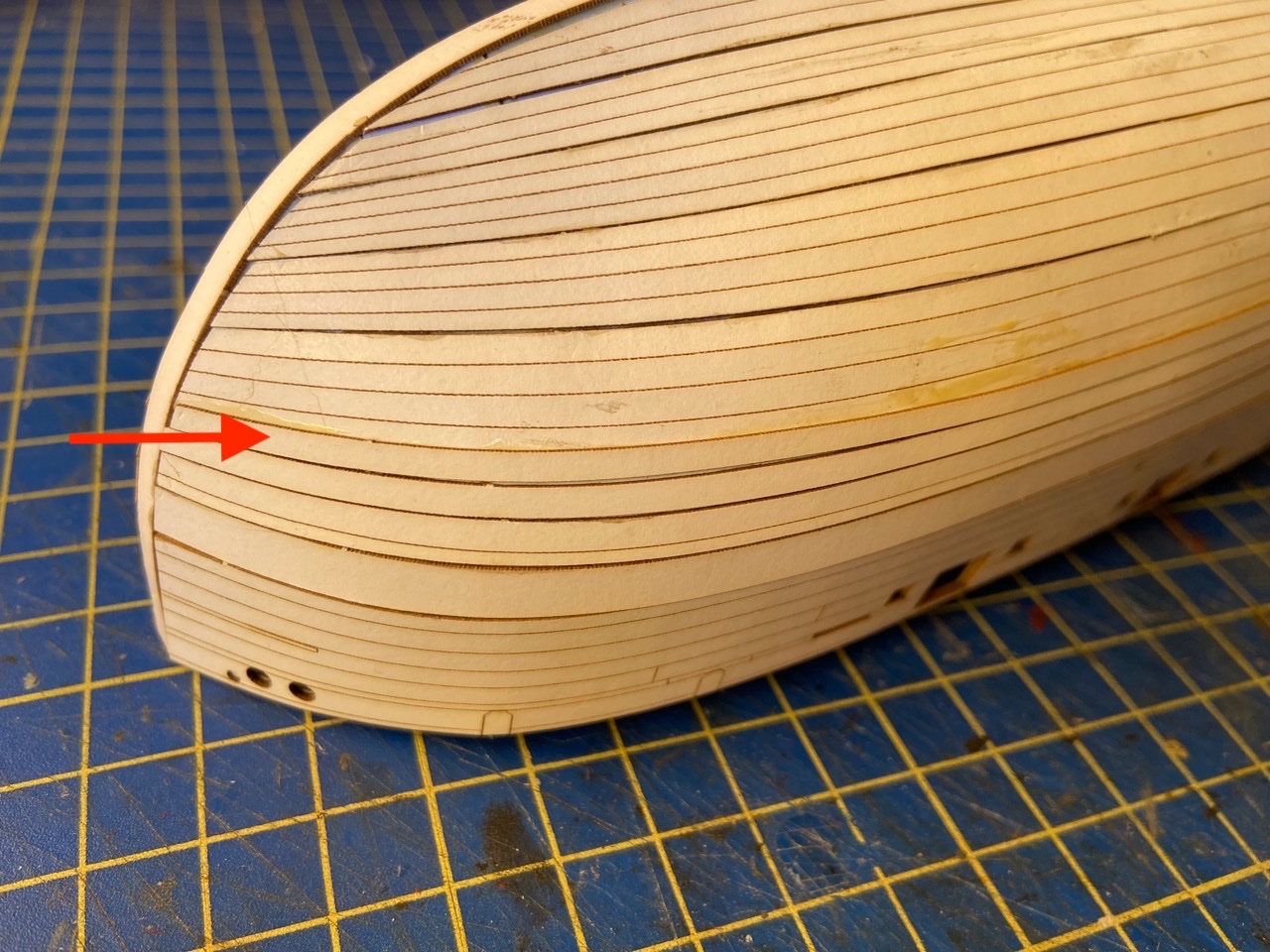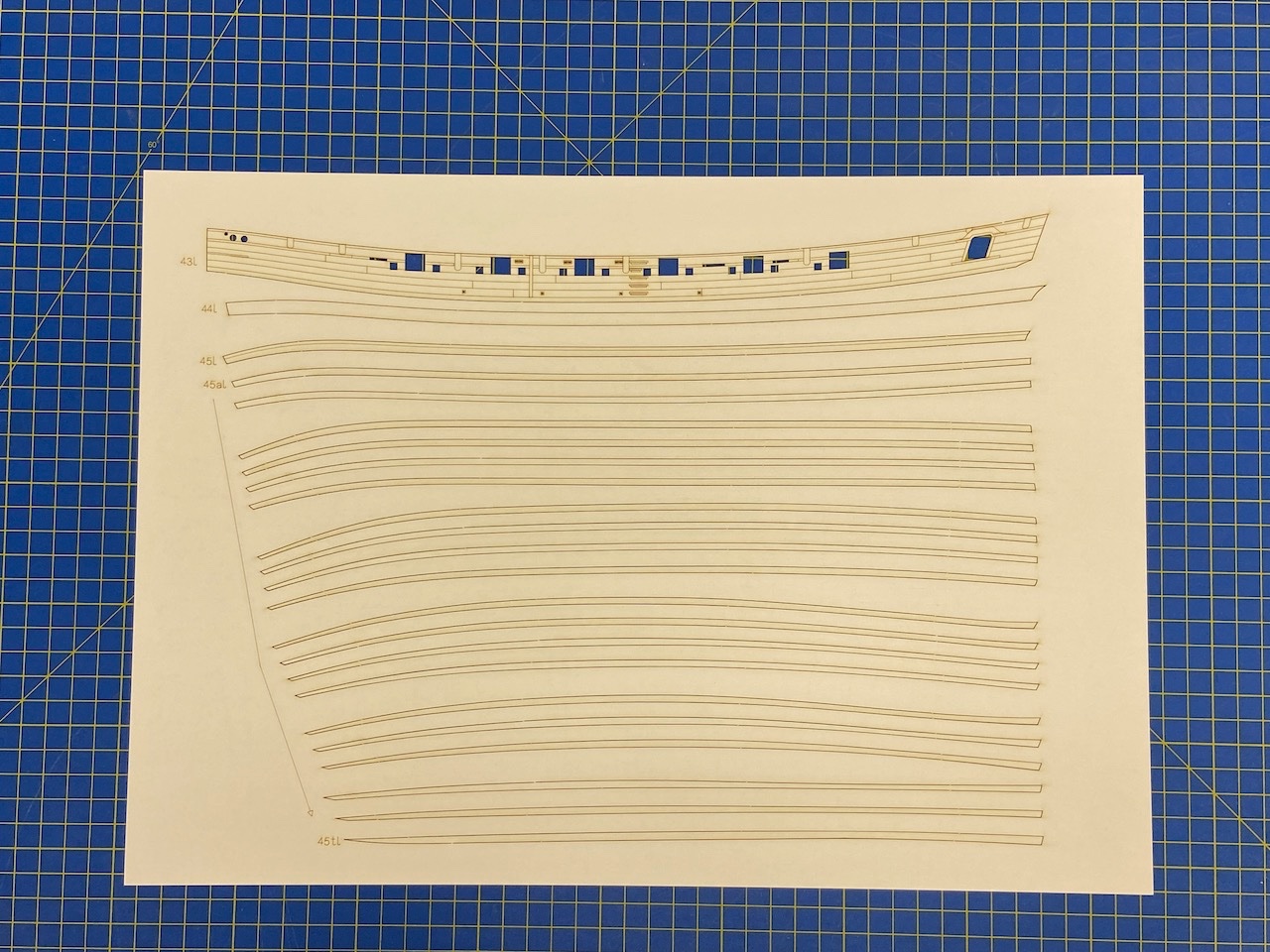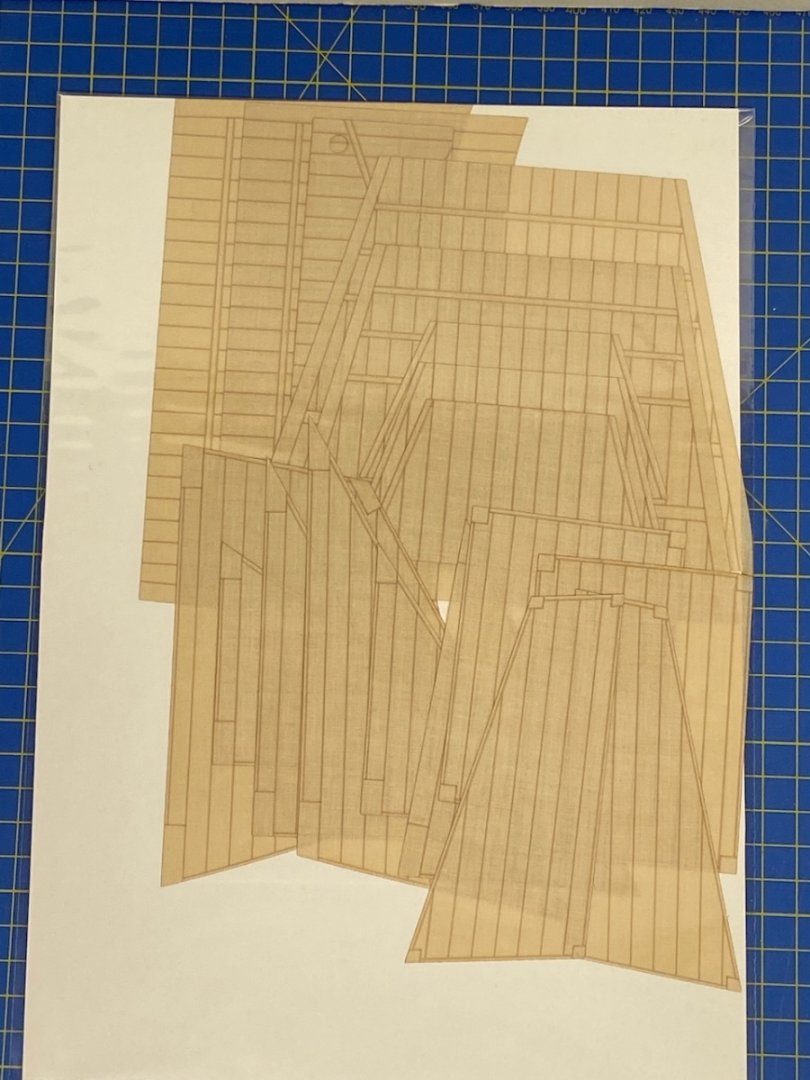-
Posts
1,858 -
Joined
-
Last visited
Content Type
Profiles
Forums
Gallery
Events
Everything posted by catopower
-
Gun carriages nearly complete, with the cannon barrels now added. Next will be to add the trunnion caps and then rig them into place on the model. Here's the model with most items on deck just test fit into place. Once the guns have been rigged in place, I'll start permanently adding all the deck furniture.
-
I too got the GPM "Super Detail Set" for HMS Mercury, same as HMS Enterprise, and I also have the new Shipyard detail set for Santa Leocadia and looked closely at the contents list and images of the Shipyard set for HMS Mercury. There is overlap between the GPM and Shipyard sets, but the GPM sets are more complete.
-

review HMS Wolf 1754, 10-gun Brig (Snow) - Shipyard - 1/72 - CARD
catopower replied to catopower's topic in REVIEWS: Model kits
Hi JohnAB, The instructions are pretty clear, but I've found that you really have to be careful with them. They will sometimes not label all of the parts you require in one photo. You just have to be cautious and look at a few of the photos to make sure you got everything you need. I'm currently up to 6 "extra" parts! Nothing serious and no one but me would ever notice. But, I still love the kit and the way it's coming along. -
Progress continues to be slow at this stage, but I did decided on the above the deck paint scheme. I'm going all red, primarily. So, red gun carriages and wheels, and red hatch coamings. I chose this, mostly because I haven't used this color scheme before and, of course, because it does fit the era. I'll save natural wood color for wooden models, at least this time. I finished assembling the gun carriages. I had the common problem of the thicker cardboard parts being a little "squishy" and prone to damage, so I gave the completed carriages a touch of thin CA glue here and there, which hardens the parts as well as the joints, making them very solid. Afterwards, I painted them red, again, using a red mixture rather than the red paint straight from the included paint jar. I also started the long process of making and adding all the eyebolts and ringbolts. 5 eyebolts and 2 rings on each cannon means making a total of 50 eyebolts and 20 rings. I'm making them because the kit provides only spools of wire for the metal parts, and because commercially available eyebolts are too large. The kit actually has you using thin copper wire that they provide. But, I found the copper to be too soft for my liking. I've always made my own eyebolts out of black annealed steel wire, so that's what I went with here. I learned to make them the hard way, and still do it, forming a closed loop in a end of a piece of wire with the aid of a drill bit to form the loop. I'm going to try to make myself switch to the simpler method of forming an eye in the middle of a piece of wire, twisted around the drill bit. But, old habits die hard. It took a while to finish the gun carriages, but most of that effort was mental – switching gears to the production of the small metal work. As long as I'm on it, I'm going to continue the process for the gun carriages of another model project that's been sitting around. Plus, I need to make all the eyebolts and ringbolts for the bulwarks for the gun tackles and breeching ropes. Then, once I get the guns dealt with, I think it will be easier to then fit the deck furniture into place.
-
Hi Chuck, that info on the Allen is something I was unaware of. Thanks for the heads up on this. I looked up Crisman's work on the Allen and found some interesting leads. You may very well be right about Amati's kit being loosely based on the Allen. Just as the Allen appears to be loosely based on designs by William Doughty. Thanks for interesting and useful leads! Of course, it won't much difference to my model, which is essentially done. But, the information is interesting enough to follow up on.
-
Thanks Henry. I'm faking it this time, just tying off the line to the halliard. But, I do need to learn to properly bend a flag to a halliard.
-
Thanks Phil (Dr. Phil?), I've been dragging my feet on this a bit, but today, I finally got around to making something in Adobe Illustrator. I haven't made a flag like this using Illustrator for a while, so I had to re-familiarize myself with the star tool. I was going to make some painting stencils using my vinyl cutter. But, seeing that this is a basic kit build, that seemed to be overkill. So, instead, I opted for a basic, fold-in-half flag printed on my Canon inkjet printer. I think it turned out quite well for what it is. The piece of line showing is not the flag halliard, but a piece of line that will help attach the flag to the halliard. I used 3M Super 77 to glue up the flag halves, and I may clean up some of white paper edge that you see on the red stripe and blue field at the top edge, or I'll just use scissors to carefully trim it. In any case, I'm pretty happy with how it turned out. As you can see, I went with the more square-ish proportions from before the flag proportions were standardized. Off to mount it on the model. Thanks all, for the help!
-
I was quite surprised yesterday when I saw that there was a new book available on the Arctic (and Antarctic) exploration ship HMS Terror of the ill-fated Franklin Expedition. What's more this is a book by Matthew Betts whose research, posted in his blog, buildingterror.blogspot.com, has been used in the development of OcCre's wooden ship model kit, in the development of the AMC miniseries The Terror, where he was also brought in as a consultant, museum displays, and more. The book is published by the Naval Institute Press. And, though they list the publication date as January 15, 2023, I have seen a photo of a copy "in the wild". The price is listed at $49.95, but apparently if you order your copy before the end of the year, you'll qualify for holiday pricing of 50% discount and free shipping – a better deal than Amazon Prime. Amazon, by the way, does carry the book, but price is $31.95 for the physical book. They also have a Kindle version for $24.99. However, you have to ignore the description of the books contents and its author, as Amazon seems to have mixed up this book by Matthew Betts with one by Ian Buxton. I have no information on the book's contents, except that it's 224 pages, and includes 250 color & b/w photos, prints, and line drawings, and the publisher's description: "This book documents the history, design, modification, and fitting of HMS Terror, one of the world’s most successful polar exploration vessels. Part historical narrative and part technical design manual, this book provides, for the first time, a complete account of Terror’s unique career, as well as an assessment of her sailing abilities in polar conditions, a record of her design specifications, and a full set of accurate plans of her final 1845 configuration. It is an ideal reference for those interested in the Franklin Mystery, in polar exploration, the Royal Navy, and in ship design and modelling." I'm sure much of the information can also be found in Betts' blog, buildingterror.blogspot.com, but I like supporting his efforts, so I ordered my copy today from NIP.
-
After a pause to get some other work done, I'm back to making some small progress on HMS Wolf. I took the time to consider the painting of the deck details, and got some ideas and information, but I'm dragging out the decision by working on parts unaffected by the decision, and working on parts that will be painted later. Some of the parts shown below need a bit more paint, but I might deal with that after some further construction work is done... Organizing assorted parts, some assembled, some not yet... Hinges on the sweep ports are incredibly tiny and there are NO SPARES... Advance work on mast tops. Why not? Capstan looks a lot better when not magnified by a camera! There are 23 parts that make up this assembly... Okay, the gun carriages don't look too bad when heavily magnified... FYI, I'm leaning towards painting the gun carriages red, and possibly the hatch coamings as well. This will make the deck very red. But, I don't have any models that display this kind of color scheme, so it will stand apart among my models. There's a long way to go yet, but I am getting close to the point where I'll have to start dealing with the masting and rigging. I've actually made up the deadeyes and just need to finish them up in preparation for mounting them. Pretty soon, I'll post photos of the full model again, once I have some of the deck furniture and other details in place. But, in the last photo of the previous post, you can see the model with most of the sweep ports in place. I actually did those a while back.
-
Thank you Henry! I knew someone here would know the facts. While the War of 1812 has always been a favorite subject of mine, it had never occurred to me that there were more states than stars on the flag during this time. I guess Amati's flag could have been one of many unofficial versions. I will probably go with the official 15 stars and 15 stripes flag. Much appreciated.
-
Just finishing up Amati's kit of an American Gunboat from the War of 1812 and I'm dealing with the flag now. FYI, this is a lateen rigged row galley that Amati calls the "Arrow" and bills it as a gunboat from the Battle of Lake Champlain. It is straight out of one of Chapelle's books, and apparently it may or may not have actually been built, but is a very interesting subject and has been a fun build. While I plan to make my own flag, I have the flag included in the kit, and it brings up the issue of a "proper" naval flag for the War of 1812. I've searched various online sources and don't see anything like this one, which shows 17 stars and 13 strips. It seems the US had 18 states at start of the war, with Louisiana becoming the 18th state in April of 1812. I would have attributed this difference to kit manufacturer error, which does happen. But, then it occurred to me that the most famous American flag, the "Star Spangled Banner" that flew over Fort McHenry, had only 15 stars (and 15 stripes). And, that seems to be the dominant configuration for any flag shown of the War of 1812. I know there was no real standardization of the American flag, and these things were hand made, and not to my knowledge by a "flag maker", but by seamstresses. Still, I have to wonder why it was made the way it was. Was there a conversation like: "How many states are there now? Ugh, one can hardly keep track of these things – they keep letting in more and more of them... Well, this one's just going to have to have 15. I'm certainly not going to redo it for the paltry sum we're getting paid." Anyway, I could certainly make a 15-star, 15-stripe flag with this gunboat, but I was wondering if anyone has more definitive info about it?
-
Ollie is right in that Artesania Latina has done a re-release of the Santa Ana kit. I don't believe anything has really changed, it's not touted as a revision, just a re-release. In any case, it's a nice looking ship. As for the plans sheet, I wouldn't suggest dismissing the kit outright because of a deleted plans sheet until after you've looked over the instructions, which can be downloaded from the AL website. You can get straight to it here. I'm sure you'll soon start to see the kit show up wherever Artesania Latina kits are sold.
-
Congratulations Snug on a fine job! Does Woody Joe know about your completed build? I know they always like to hear about such things. I'll have to add the kit to my list. Plus, now is a really good time to buy from Japan, given the exchange rates.
- 63 replies
-
- Finished
- Khufus Solar Boat
-
(and 1 more)
Tagged with:
-
The Swampscott dory is a really nice looking boat. I built that kit back when it was still made by Laughing Whale. It was something like the 5th wooden kit I'd ever built, and I remember the hull was just a tad crooked. Your's looks great. Probably just need to lower the keel and clip some more ballast to the end of it.
- 11 replies
-
- Swampscott Dory
- Finished
-
(and 1 more)
Tagged with:
-
I'll add that the Yen is also at its lowest point in 24 years, so it is also an excellent time to buy a Woody Joe or other kit from Japan. Good source, as I always recommend, is Zootoyz.jp. Excellent service. Shipping from Japan is expensive, but the exchange rate helps out there too.
-
There's a bit of a big leap here from my last post, which didn't have any of the railings. That was a bit of a challenge, mostly in trying to keep all the timber heads straight, as well as adding the swivel gun stanchions. The small timber head pieces that stick up from the rail at the bow are simply glued on to the rail. The pieces are very small, and a bit tricky to mount properly over the lower parts that form rail stanchions. On top of that, they need to be straight. I thought mine were okay, but a closer look showed I was wrong. So, I ended up removing some of the timber heads, cleaning them up, and re-mounting them. Finally, I come to one of the big steps in the model’s construction, one that I have been waiting anxiously for: the figurehead and decorative carvings. The figurehead itself and the carvings across the top of the transom and along its sides are made of cast resin and come pre-painted in a bright gold finish. Apparently, in more recent kits, these come un-finished. The figures at the sides of the transom were a bit tall to fit easily, tucked into the spaces for them, so I had to trim the bottoms of these until they fit, after which I could glue them into place. In addition, there were a number of highly decorative laser-etched card pieces that made up the decorations around the quarter gallery windows, as well as some kind of dolphin decorations that fit along the nearby fashion pieces at the stern. I pre-painted all of these using some gold-colored acrylic paint that was included in the kit. Later on, in order to make the details on these decorations stand out more, I thinned down some brown paint and carefully brushed it into the recesses of the scroll work. Then, I re-applied some gold paint to the high spots on the decorations. Note also that I added the rudder into place, along with the rudder hinges. It’s definitely not perfect. I placed the rudder hinges according to the markings that were visible on the rudder and on the hull’s sternpost. Not perfect, but it looks okay. I have yet to add eyebolts for the mounting of the preventer chains, which would provide an alternative method of steering the ship if the tiller gets shot away in battle. It also would keep the rudder from floating away if it ever breaks loose in battle or in a severe storm. At the bow, these models feature an object that you rarely see on a kit model. If you look at the base of the stem you can see the horseshoe, which helps fasten the components of the stem together. At this point, the model shows off the level of detail provided in this kit, and it gives a sense of how detailed all of these laser-cut card kits from Shipyard are. I’ve come to realize that I am going to absolutely finish building not only this kit, but I’m going to have to build their other 1/72 scale laser-cut card kits, HMS Alert, Papegojan, possibly the Le Coureur, and most definitely, their massive HMS Mercury kit. At least, that is, unless something happens to change my mind about the kits. By the way, I found the details a bit washed out on the decorative pieces, so I've started to give them a wash of brown paint to try to fill in the deep set areas and give the details a bit more contrast. Hopefully, that's starting to show. For now, I’ll be working on this kit, and I’m afraid the apparent progress will start to slow down a lot as I get more and more into the smaller details. I’m starting to consider a few options, like what color the hatch coamings and the gun carriages will be, what I’m going to be doing about the sails, how I will be mounting the model, whether I’m going to use the provided laser-cut card blocks and deadeyes or use wooden ones, etc. Regarding the hatch coamings and deck details, the kit instructions call for most every structure on the deck to be painted red, except for the hatch coamings and gun carriages, which are shown to be left a natural wood color. I was contemplating painting these items red as well. But, now, I'm wondering if I should just paint all the deck furniture a natural brown color? Any thoughts? There seems to be a more recent trend in wooden ship modeling to paint deck furniture red. The old tradition was leaving things natural. But, that was to show off the wood of a model. This model is not wood, so there's no need to show off wood. Still, wood colored deck furniture will make the model look more like it's wooden cousins, which is part of a valid visual effect for a paper/card model. Opinions are welcome! Below, you can see the hatch coamings dry fit into place to give some idea of what I'm talking about.
-

review HMS Wolf 1754, 10-gun Brig (Snow) - Shipyard - 1/72 - CARD
catopower replied to catopower's topic in REVIEWS: Model kits
Very nice BenD! Interestingly enough, I must have an older kit. Mine still has brass cannons, and while the figurehead and carvings are cast resin, mine came pre-painted! My swivel guns need to have the handles made for them, but the instructions really don't make it clear just how to do that. I guess it won't matter for the new crop of kits anyway. By the way, you're right about paint needing thinning. But, on the upside, there's WAY more paint provided than you'll need for this kit. -
Very nice, meticulous work, Johnny. I think there may be some light at the end of the tunnel... Your project is reminding me that I need to get back to completion of a couple Woody Joe projects I've got!
- 63 replies
-
- Finished
- Khufus Solar Boat
-
(and 1 more)
Tagged with:
-
Next step was to add the friezes to the hull. This comes as, if I recall exactly, five separate pieces for each side of the hull. The gun ports and sweep ports provide the perfect guides for alignment of these printed pieces of paper. This printed paper, by the way, is the only thing in the whole kit that needs to be cut by hand. Then, the build actually gets a little tricky, when it comes time to add all the moldings that border the friezes. You have to look at the instructions very carefully to make sure the right pieces go in the right places. It can be very easy to get mixed up, and there are also some REALLY TINY pieces. With no extra pieces provided, this is one place where you have to be super careful with the build. Below, you can see the first really noticeable mistake. I didn’t notice when I glued the clear acetate to the back of the quarter gallery window frames and the frames on one side got deformed in the process. I left it, rather than trying to fix it and probably destroying it. I may eventually see if I can make the deformity less noticeable. But, for now, it’s only really noticeable in a close-up photo. The next mistake, which I did manage to overcome was this knee. I thought it was a single piece, but turns out there was a second piece. They were supposed to be glued together to form one, thicker knee. But, the instructions don’t really make it clear and I only figured it out when I found the second piece. I just sliced the second piece in half and glued each slice to either side of the knee that was already in place. Problem solved! The stern gallery was another one of those cool detailed assemblies that would really stand out on the model. This one was 29 pieces, including the frieze. And, here’s the model at this stage, with all the moldings in place. I was afraid that some of these molding pieces might get knocked off, so I made sure to brush some diluted Aleene’s Tacky Glue along the edges of the molding pieces to help secure them. Even so, I’m extra careful with the model as I’m working on it.
-
As I mentioned last time, I had some high spots with the edges of some planks, so I did a bit of light sanding, and applied some gesso to the bottom of the hull to fill in any gaps in the planking. Finally, I used my waterline marker to define the waterline, then masked it off using some Tamiya brand masking tape. Following the kit instructions, I painted the upper hull yellow and then re-masked and painted the bottom white. I decided I didn’t want to use the paint straight out of the provided jars, as the colors seemed too intense. My initial concern was really about the use of red. The outside hull gets some pre-printed frieze design with red background that looked like it matched the color of the paint straight from the jar. Fortunately, the designs were only on the outside of the hull. All my painting of red would be on the inside of the hull. So modifying the red color shouldn't cause any issues. As for the yellow, I lightened it up to reduce the intensity a little, which I decided was only on the outer hull, so it shouldn’t be an issue there either. Below is the first piece of the printed frieze design. I don’t know if the design was actually on the operational ship, or if it only appeared in some painting somewhere of the proposed ship, or if it might have eventually been painted over. I considered not using it. But, it adds so much to the decorative nature of the model that I saw no good reason to leave it off. Sorry the lighting wasn't very good for seeing the artwork in the photo. At last, I got to work on the face of the stern cabin, which is such a cool little project and looks so nice on the model. I decided to paint it red, but to give some depth to it I painted the underlying piece a dark brown to add contrast. I also painted the columns brown as well. There are several pieces, and it was a lot of fun to put this all together. I think there were 22 or 23 pieces, not including 5 clear acetate pieces for the window glass, which was added later and glued into place using Formula ‘560’ Canopy Glue, which dries clear. After that, I added the wales, which covered up some of the irregularities in the hull that were bothering me. I painted the wales black before applying it, then I finished off painting the black portion of the stem. The inner bulwarks pieces went in just fine, though they were just a tad long. I carefully lined them up with the gunports to figure out which end I had to trim and by how much. You can’t see it in the photos, but the bottom edges at the forecastle showed a little gap, so before gluing those forward pieces into place, I painted the hull behind the pieces first where the bottom edge would show through. So, now, you can’t see the gap so well. Painting the inner edges of the gun ports and the sweep ports resulted in getting a little paint on the outside of the hull. So, I had to clean up as best I could as I went along, then touched up the outer hull with the yellow paint. I am super thrilled about how nicely this model has been turning out, and I find it just incredible to get this far so quickly, and to have something so beautiful and amazingly detailed in my hands.
-
So I'm still contemplating the color of the gun carriages and hatch coamings. Also considering how I want to do the sails. The kit sails are nice, all pre-cut, and laser-etched with the panel markings and reef bands. But, I don't know how I want to present the ship just yet. I have time to think about this, but I'll need to decide on the hatch coamings and gun carriages soon. In the meantime, the addition of the hull's third layer begins. The third layer of the hull is pretty much actual, individual hull planks, with the exception of the bulwarks. There are two sheets of thin, laser-cut card stock for this layer, one for each side of the hull. It's nice how the planking is all pre-spiled, In the image below, some of the individual planks have been glued into place. To make it clearer, I marked the last plank to go on with an arrow. The planks are added from the bulwarks down toward the keel, as per the instructions. Note how the second layer's markings serve as a guide for the placing of this final layer's individual planks. But, you can see that it's a bit hard to line the pieces up exactly, as I had some trouble getting the second layer to lay down nicely at the bow. This didn't turn out to be that big an issue. It was just a matter of time before I had all the planks added. I ended up with some gaps close to the end, but the whole model gets painted later anyway so it wasn't a problem. There is some excess length to the planks, so that has to be trimmed trimmed off. Below, you can see I’ve now added the keel and stem. I had some high spots with the edges of some of the planks still, so I did a little light sanding. I also applied some gesso to the bottom of the hull to fill in some of those gaps in the planking prior to painting the hull, which will come up next. There's a little bit of unevenness at the base of the bulwarks piece, but this should be pretty well covered by the addition of the wales.
About us
Modelshipworld - Advancing Ship Modeling through Research
SSL Secured
Your security is important for us so this Website is SSL-Secured
NRG Mailing Address
Nautical Research Guild
237 South Lincoln Street
Westmont IL, 60559-1917
Model Ship World ® and the MSW logo are Registered Trademarks, and belong to the Nautical Research Guild (United States Patent and Trademark Office: No. 6,929,264 & No. 6,929,274, registered Dec. 20, 2022)
Helpful Links
About the NRG
If you enjoy building ship models that are historically accurate as well as beautiful, then The Nautical Research Guild (NRG) is just right for you.
The Guild is a non-profit educational organization whose mission is to “Advance Ship Modeling Through Research”. We provide support to our members in their efforts to raise the quality of their model ships.
The Nautical Research Guild has published our world-renowned quarterly magazine, The Nautical Research Journal, since 1955. The pages of the Journal are full of articles by accomplished ship modelers who show you how they create those exquisite details on their models, and by maritime historians who show you the correct details to build. The Journal is available in both print and digital editions. Go to the NRG web site (www.thenrg.org) to download a complimentary digital copy of the Journal. The NRG also publishes plan sets, books and compilations of back issues of the Journal and the former Ships in Scale and Model Ship Builder magazines.

